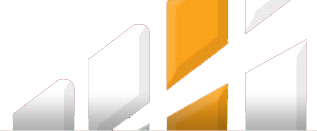|
|
THE TOBACCO CONTROL REGULATIONS
ARRANGEMENT OF REGULATIONS
PART I – PRELIMINARY
| 1. |
Citation and commencement
|
PART II – PACKAGING AND LABELING
| 3. |
Health warnings and messages in pictures and pictogrms
|
| 4. |
Prohibition against dealing in devices used to cover, obscure etc Health messages
|
| 5. |
Health message to be on both wrapper and packet
|
| 6. |
Rotation of specified health warnings and messages
|
| 7. |
Format of health warnings and messages
|
| 8. |
Prohibition on certain product descriptions
|
| 9. |
Product identification markings
|
| 11. |
Display of signs at point of sale
|
PART III – INFORMATION TO BE PROVIDED BY MANUFACTURERS AND IMPORTERS
| 14. |
Offence under this Part
|
PART IV – PROTECTION AGAINST EXPOSURE TO SECOND-HAND TOBACCO SMOKE
| 15. |
Prohibition of smoking in private vehicles and near public place
|
| 16. |
Notice on prohibited smoking area
|
| 17. |
Supervision of non-smoking area
|
| 18. |
Certification of compliance on designated smoking area
|
PART V – PUBLIC TOBACCO INDUSTRY INTERACTIONS
| 22. |
Limitation on interaction
|
| 26. |
Disclosure on intention to engage with tobacco industry
|
| 27. |
Disclosure of prior engagement with tobacco industry
|
| 28. |
Public Officer to declare and divest interests
|
| 29. |
Prohibition on participation as delegate in Conference of Parties
|
| 30. |
Prevention of interference
|
| 31. |
Prohibition of monetary and non-monetary gifts
|
| 32. |
No preferential treatment of tobacco industry
|
| 33. |
Upholding of public health policies
|
| 34. |
Annual reports of public authorities
|
| 35. |
Offences of subverting tobacco control and related public health policies
|
| 36. |
Offences committed by tobacco industry
|
PART VI – TOBACCO CONTROL FUND
| 37. |
Solatium contribution
|
| 38. |
Forfeiture of property
|
PART VII – ENFORCEMENT
| 39. |
Authorized Officers and Responsible Persons
|
PART VIII – MISCELLANEOUS PROVISIONS
| 42. |
Access to information
|
| 43. |
Monitoring and Reporting
|
| 45. |
Offences and general penalty
|
SCHEDULES
| FIRST SCHEDULE [r. 3(1), 7(1), 16] — |
LIST OF PRESCRIBED HEALTH WARNINGS AND MESSAGES INCLUDING CORRESPONDING PICTOGRAMS
|
| SECOND SCHEDULE [r.7 (2)(b), 7(2)(c),7(3)] — |
HEALTH WARNINGS FOR DISPLAY
|
| THIRD SCHEDULE — |
SEIZURES AND SAMPLING FORMS
|
| FOURTH SCHEDULE — |
CERTIFICATE OF COMPLIANCE OF DESIGNATED SMOKING AREAS
|
THE TOBACCO CONTROL REGULATIONS, 2014
PART I – PRELIMINARY
| 1. |
Citation and commencement
These Regulations may be cited as the Tobacco Control Regulations, 2014 and shall come into operation, upon the expiry of six months from the date of its publication in the Gazette.
|
| 2. |
Interpretation
In these Regulations, unless the context otherwise requires —
"Act" means the Tobacco Control Act, 2007;
"exposure" means the subjection of a person to an environment where smoking is taking place, has taken place or that contains the remains of any used tobacco product including, among others, cigarette stubs;
"financial year" means the period of twelve months ending on the 30th of June in each year;
"health warnings and messages" means the health warnings and messages referred to in section 21 and the Schedule to the Act and such other health messages as may be specified by the Cabinet Secretary from time to time;
"partially covered" means any space covered by a roof or enclosed by one or more walls or sides, regardless of the type of material used for the roof, walls or sides and regardless of whether it is permanent or temporary;
"point of sale" means any place where tobacco products are distributed, or sold as wholesale or retail;
"predominant local language" means any other language that is not a national language but is commonly used by the majority of the population residing in a particular area;
"principal display area" includes in the case of —
| (a) |
box type packages, two equal sized largest surface areas of the box that may be displayed or visible under normal conditions of sale or use;
|
| (b) |
pouch type packages, the entire surface area of the pack that may be displayed or visible under normal conditions of sale or use;
|
| (c) |
conical or cylindrical type of packages, the entire curved area of the pack that may be displayed or visible under normal conditions of sale or use;
|
| (d) |
any other form or type of package, the entire surface area of the pack that may be displayed or visible under normal conditions of sale or use;
|
"second-hand smoke" means smoke emitted from the burning end of a cigarette or any other tobacco products in combination with the smoke exhaled by the smoker;
"pictures or pictograms" means such graphics as are specified under these Regulations or as the Cabinet Secretary may from time to time specify;
"workplace" means any place used by people in their employment or work and all attached or associated places including vehicles used in the course of employment,
geriatric homes and residential houses.
|
PART II – PACKAGING AND LABELING
| 3. |
Health warnings and messages in pictures and pictogrms
| (1) |
A person who manufactures, sells, distributes or imports a tobacco product shall ensure that every package containing the tobacco product bears warning labels and information required under section 21 of the Act and specified in the Schedule to the Act and the corresponding pictures and pictograms set out in First Schedule.
|
| (2) |
The manufacturer, seller, distributor or importer of a tobacco product shall ensure that the health warning and message including a pictogram or picture required under paragraph (1) is not distorted or likely to be damaged, concealed, obliterated, removed or rendered permanently unreadable when the package on which it is printed is opened in the normal way.
|
| (3) |
A picture and pictogram required under paragraph (1) shall be in full colour with contrasting colours for the background in a manner that maximizes noticeability and legibility of elements of health warnings and messages in the approved layout and design.
|
|
| 4. |
Prohibition against dealing in devices used to cover, obscure etc Health messages
| (1) |
No person shall manufacture, sell, distribute, or import a tobacco product, device or any other thing that is intended to be used to cover, obscure, mask, alter, or otherwise detract from the display of specified health warnings and messages including pictures and pictograms under the Act or these Regulations.
|
| (2) |
A person shall not design the package or parts of the package, or accessories thereto, with an cover that may obscure the prescribed health warnings and messages including pictograms or pictures.
|
|
| 5. |
Health message to be on both wrapper and packet
Where the health warnings and messages including pictograms that are required to be printed on packages are likely to be obscured or obliterated by a wrapper on the package, the manufacturer, seller, distributor or importer of the tobacco product shall ensure that the health warnings and messages shall be printed on both the wrapper and the packet.
|
| 6. |
Rotation of specified health warnings and messages
| (1) |
The manufacturer, seller, distibutor or importer of a tobacco product shall ensure that the specified health warnings and messages including pictograms required under these Regulations are rotated in accordance with section 21 (3) of the Act.
|
| (2) |
When an old set of health warnings and messages including pictures and pictograms are being replaced by a set of new ones, both sets may continue to be used during the transition period.
|
| (3) |
For the purposes of paragraph (1), the twelve month rotational period referred to in section 21 (3) of the Act shall be a period of twelve months ending on the 31st December in each year.
|
|
| 7. |
Format of health warnings and messages
| (1) |
The health messages required under these Regulations on all packages shall be in the form of a text message specified in the Schedule to the Act and a prescribed pictorial message set out First Schedule.
|
| (2) |
The text of the health message on the front face of a package shall —
| (a) |
be printed in white on a black background;
|
| (b) |
be printed in the type face known as Helvetica, in uppercase and lower-case letters as set out in the Second Schedule;
|
| (c) |
| (ii) |
subject to paragraph (d), of the same font size throughout the message; |
| (iv) |
of normal and bold weight as set out in the Second Schedule; and |
| (v) |
of a size that makes the text as nearly as possible fill the background on which it is printed; and |
|
| (d) |
bear the word "WARNING" which shall be in type of a font size not greater than fifty per cent of the font size of the type used for the text message.
|
|
| (3) |
A warning message on the back face of a package shall be —
| (a) |
printed on a white background;
|
| (b) |
printed in the type face known as Helvetica, in upper-case and lower-case letters as set out in the Second Schedule;
|
| (c) |
| (ii) |
subject to paragraph (d), of the same font size throughout the message; |
| (v) |
of such a size that the text as nearly as possible fills the background on which it is printed; and |
|
| (d) |
the word "WARNING" which shall be in type of a font size not greater than fifty per cent of the font size of the type used for the text message.
|
|
| (4) |
The health message place on the front face of the package shall be in English and a Kiswahili version of the health message shall be placed on the back face of the package.
|
|
| 8. |
Prohibition on certain product descriptions
A person shall not manufacture, sell, distribute, or import a tobacco product, for sale in Kenya, whose package carries a name, brand name, text, trademark or pictorial or any other representation or sign which suggests that the tobacco product is less harmful to health than other tobacco products.
|
| 9. |
Product identification markings
| (1) |
The package of every tobacco product shall contain a code marking, whether by batch numbering or otherwise through which the place, the date of manufacture and country of origin may be determined.
|
| (2) |
A manufacturer shall, upon request, provide the Cabinet Secretary with such information as shall be required to enable the Cabinet Secretary interpret the code marking on a tobacco product for the purpose of any of the Cabinet Secretary's functions under the Act or these Regulations.
|
|
| 10. |
Technical Repository
The Cabinet Secretary shall maintain —
| (a) |
a technical repository containing the required pictures, pictograms, health warnings and messages as well as related technical information to facilitate the implementation of Act and these regulations; and
|
| (b) |
a digital storage device which shall have the required pictures and pictograms and guidance documents on the application of the pictograms under this Part which shall be available to any interested person.
|
|
| 11. |
Display of signs at point of sale
| (1) |
Any sign pursuant to section 16 of the Act shall —
| (a) |
bear the words ‘The sale of or the availing of a tobacco product to a person under the age of eighteen years is prohibited by law’;
|
| (b) |
be predominantly displayed at the point above the level of the counter, shelf or container from which these products are stored for sale or sold; and
|
| (c) |
bear a black border around it.
|
|
|
PART III – INFORMATION TO BE PROVIDED BY MANUFACTURERS AND IMPORTERS
| 12. |
Product disclosure
| (1) |
A manufacturer or importer shall, at the end of each calendar year, provide the Cabinet Secretary, for each type of tobacco product and for each brand manufactured or imported —
| (a) |
a list of all the ingredients that the tobacco product contains including the quantities of those ingredients per unit of tobacco product and ingredients present in tobacco product components such as filters, glue and papers for each brand;
|
| (b) |
a statement of the reasons for the inclusion of those ingredients which shall indicate for each ingredients —
|
| (c) |
all toxicological data available to the manufacturer concerning the ingredients of that tobacco product in the case of products intended to be burnt or unburnt or of products not intended to be burnt or unburnt which shall for each ingredient —
| (i) |
refer in particular to their effects on health; |
| (ii) |
include any effects produced in combination with any of the other ingredients of that product that are not produced by that ingredient alone; and |
| (iii) |
include any addictive effects. |
|
| (d) |
information on the characteristics of the tobacco leaves used including —
| (i) |
the type of tobacco leaves and percentage of each type used in the tobacco product; |
| (ii) |
the percentage of reconstituted tobacco used; |
| (iii) |
the percentage of expanded tobacco used; and |
| (iv) |
changes to tobacco product ingredients when any change is made; and |
|
| (e) |
any information concerning the renaming or discontinuation of any brand produced by the manufacturer within the preceding twelve months.
|
|
|
| 13. |
Industry dislosure
A manufacturer shall, at the end of every calendar year, submit a report to the Cabinet Secretary on —
| (a) |
the quantity of tobacco products produced in the immediately preceding calendar year;
|
| (c) |
sales made and revenues earned;
|
| (d) |
quantities exported where applicable; and
|
| (e) |
affiliated organizations and its agents or persons acting on its behalf.
|
|
| 14. |
Offence under this Part
A person who declares false information under this Part commits an offence.
|
PART IV – PROTECTION AGAINST EXPOSURE TO SECOND-HAND TOBACCO SMOKE
| 15. |
Prohibition of smoking in private vehicles and near public place
Pursuant to section 32 and without prejudice to section 33 (1) of the Act on second-hand tobacco smoke, no person shall smoke in —
| (a) |
a private vehicle where children are on board; or
|
| (b) |
streets, walkways, verandas adjacent to a public place.
|
|
| 16. |
Notice on prohibited smoking area
A notice displayed pursuant to section 34 of the Act shall —
| (a) |
bear the word 'WARNING' in capital letters, in red colour on a white background and in Helvetica type font;
|
| (b) |
bear the words 'It is an offence to smoke in this premises' in black colour on a white background and followed by a no smoking sign composed of a black burning cigarette encircled in red as set out in the First Schedule;
|
| (c) |
bear the words 'Penalty, Kshs. 50,000/- or imprisonment for a term of 6 months or both' appearing at the bottom of the notice;
|
| (d) |
consist of at least A3 paper size;
|
| (e) |
be posted at the main entrance, other entrances and appropriate locations of a prohibited smoking area; and
|
| (f) |
have a black border around it.
|
|
| 17. |
Supervision of non-smoking area
The manager or owner of a prohibited smoking area shall —
| (a) |
ensure that ash trays and all other accessories used to consume tobacco products are removed from the area;
|
| (b) |
supervise observance of a smoke free environment;
|
| (c) |
take steps to discourage individuals from smoking on the premises including —
| (i) |
require a person not to smoke or to stop smoking in the area; |
| (ii) |
discontinue services to the person smoking in the area; |
| (iii) |
require a person to leave the premises; or |
| (iv) |
contact an authorized officer or law enforcement officer and authorities to enforce the law if a person refuses to comply. |
|
|
| 18. |
Certification of compliance on designated smoking area
The manager or owner of premises who intends to establish a designated smoking area in accordance with section 35 of the Act shall obtain a certificate of compliance from the Director of Medical Services in the form set out in the Fourth Schedule.
|
| 19. |
Technical repository
The Cabinet Secretary shall establish and maintain —
| (a) |
a technical repository of required No Smoking Warnings and any other related technical information to facilitate their printing; and
|
| (b) |
a digital storage devise with the required No Smoking Warnings and any other related technical information to facilitate their printing which shall be available to any interested person.
|
|
PART V – PUBLIC TOBACCO INDUSTRY INTERACTIONS
| 20. |
Interpretation
In this part —
"business" includes trade or profession;
"company" includes any body corporate;
"Conference of Parties", means the Conference of Parties established under Article 23 of the World Health Organization Framework Convention for Tobacco Control ;
"director", in relation to a body corporate whose affairs are managed by its members, means a member of the body corporate;
"holding company" or "subsidiary company" have the meanings assigned to them under the Companies Act (Cap. 486), Customs and Excise Act (Cap. 472);
"interactions" means meetings, correspondences and other exchanges between public authorities and the tobacco industry or its affiliates that arise when public authorities meet in a common forum with the tobacco industry or its affiliates whether directly or through third parties;
"public authority" means a body or legal and natural persons whose functions are of a public nature and any person acting on behalf of a public authority and includes all bodies and persons whose ownership, funding and control vests in the State;
"public officer" has the meaning assigned to it under the Article 260 of the
Constitution of Kenya, 2010.;
"relevant contractual arrangement" means any contractual arrangement pursuant to which all or some of the affairs of a party to that arrangement, which is incorporated or otherwise organised outside Kenya, are conducted in accordance wholly or partly with the wishes of a company, incorporated in Kenya is also party directly or indirectly to the arrangement;
"senior officer" in relation to —
| (a) |
a body corporate, means a director, manager, secretary or other similar officer of the body corporate;
|
| (b) |
a partnership, means a partner or any person who has control or management of the business of the partnership;
|
"tobacco industry" means tobacco manufacturers, wholesale distributors, importers of tobacco products, tobacco growers and its associations and includes other entities representing them, tobacco industry lobbyists or persons working to further the tobacco industry's agenda;
"tobacco industry interference" means any commercial or vested interest on the tobacco industry that subvert or undermine development, implementation and enforcement of public health policies, measures and laws for tobacco control.
|
| 21. |
Application of Part
This Part shall apply to all interactions between public authorities and the tobacco industry.
|
| 22. |
Limitation on interaction
| (1) |
Any interactions between public authorities or public officers and the tobacco industry shall be limited to the extent strictly necessary for effective tobacco control and enforcement of relevant laws.
|
| (2) |
A minimum of two public officers shall be present in any interactions with the tobacco industry.
|
| (3) |
Before commencing any interaction with the tobacco industry, the public officers shall state, in writing, that the interaction does not imply an endorsement of tobacco industry practices and that no relationship, collaboration or partnership shall be construed whatsoever from the interaction.
|
| (4) |
Any public officer participating in any interaction with tobacco industry shall prepare a formal record of the interaction and submit to the relevant public authorities including the Cabinet Secretary on request.
|
| (5) |
Interactions with the tobacco industry initiated by a public authority at the national, regional, county, district, urban authority or local level shall take place in public venues determined by the public authority.
|
| (6) |
Interactions with the tobacco industry shall not take place within offices or other facilities of the tobacco industry except in the course of enforcing or ensuring compliance with the law.
|
| (7) |
A public authority or public officer shall not accept any offers of hospitality from the tobacco industry or its affiliates.
|
| (8) |
A public authority shall not accept any direct or indirect funding from the tobacco industry or endorse projects, which are funded directly or indirectly by the tobacco industry.
|
|
| 23. |
Disclosure
| (1) |
A public officer who has any interest whether pecuniary or business interest in tobacco industry shall disclose the nature of the interests to the respective public authority, on commencement of employment and as soon as the relevant facts have come to his or her knowledge in accordance with the Public Officers Ethics Act, 2003 (No. 4 of 2003).
|
| (2) |
A disclosure of interest under paragraph (1) shall be recorded by every public authority.
|
| (3) |
A public officer having made such disclosure shall subject to section 12 of the Public Officer Ethics Act, 2003, not under any circumstances —
| (a) |
be present during any interactions of the public authority with the tobacco industry;
|
| (b) |
take part in the decision making of the public authority relating to the tobacco industry;
|
| (c) |
be present during the deliberations of any public authority for the making of that determination; and
|
| (d) |
influence directly or indirectly any other member or decision making of the Public authority.
|
|
| (4) |
A person who contravenes this Regulation commits an offence.
|
|
| 24. |
Code of conduct
The Cabinet Secretary shall prescribe a code of conduct prescribing standards for any public officer including service providers, contractors consultants involved in setting or implementing public health policies for tobacco control.
|
| 25. |
Award of contracts
A public authority shall not award contracts for carrying out any work related to setting and implementing public health policies with respect to tobacco control to candidates or tenderers who have conflicts of interest with established tobacco control policies.
|
| 26. |
Disclosure on intention to engage with tobacco industry
A public officer who has or had a role in setting and implementing public health policies with respect to tobacco control shall —
| (a) |
inform the respective public authority where the person served, about any intention to engage in an occupational activity within the tobacco industry, whether gainful or not within a period of at least three years after leaving service; and
|
| (b) |
not engage in such occupational activity within a period of three years from the time the persons ceases being a public officer.
|
|
| 27. |
Disclosure of prior engagement with tobacco industry
A person applying for a public office which has a role in setting and implementing public health policies regarding tobacco control shall declare any current or previous occupational activity with any tobacco industry whether gainful or not.
|
| 28. |
Public Officer to declare and divest interests
A public officer who has a role in setting and implementing public health policies with respect to tobacco control shall declare interest in the tobacco industry to the Cabinet Secretary and divest himself or herself of direct interests in the tobacco industry.
|
| 29. |
Prohibition on participation as delegate in Conference of Parties
A person employed by the tobacco industry or any setting working to further the interests of the tobacco industry shall not serve on Kenyan delegations to meetings of the Conference of Parties, its subsidiary bodies or any other bodies established pursuant to decisions of the Conference of the Parties.
|
| 30. |
Prevention of interference
A public authority shall —
| (a) |
promote tobacco control and prevent tobacco industry interference within its mandate, plans and activities;
|
| (b) |
adopt mechanisms to raise awareness within its mandate about the interference and vested interests of tobacco industry with the development and enforcement of tobacco control legislations and policies;
|
| (c) |
not accept, support or endorse partnerships, sponsorships, services and any monetary or non-monetary assistance from the tobacco industry except for compensations due to legal settlements or as mandated by applicable law;
|
| (d) |
not enter into or endorse non-binding or non-enforceable agreements or any voluntary arrangement or joint tobacco control and other activities with the tobacco industry;
|
| (e) |
not accept, support or endorse the tobacco industry organizing, promoting, participating in, or performing, children, youth or public education or any initiatives that are directly or indirectly related to tobacco control;
|
| (f) |
not endorse, support, form partnerships with or participate in activities of the tobacco industry described as corporate social responsibility;
|
| (g) |
restrict involvement of tobacco industry in the development of tobacco control policies and laws except in public forums where the industry is presenting its views to the public authority on relevant tobacco control laws and polices;
|
| (h) |
not allow any person employed by the tobacco industry or any entity working to further its interests to be a member of any government body, committee or advisory group that sets or implements tobacco control or public health policy.
|
|
| 31. |
Prohibition of monetary and non-monetary gifts
| (1) |
Any entity which is part of the tobacco industry shall not grant any monetary and non-monetary payments, gifts and services to public authorities or a public officer.
|
| (2) |
A public authority or officer shall not receive any monetary or non monetary payment,
gift or favour from tobacco industry.
|
| (3) |
A public authority or officer who contravenes this Regulation commits an offence.
|
|
| 32. |
No preferential treatment of tobacco industry
A public authority shall not grant incentives, privileges, benefits or any other preferential treatment to the tobacco industry to establish or run their businesses.
|
| 33. |
Upholding of public health policies
| (1) |
A public authority shall, while implementing investment and tax laws and other policies related to tobacco, be guided by the priority to tackle the adverse health,
social, economic and environmental impacts of tobacco growing, manufacture, sale and consumption in Kenya.
|
| (2) |
The Cabinet Secretary for the time being responsible of agriculture shall pursuant to section 13(1) of the Act put in place policies to promote appropriate, economically viable alternatives for tobacco growers.
|
|
| 34. |
Annual reports of public authorities
| (1) |
Every public authority involved in tobacco control shall, at the end of every calendar year, prepare and submit an annual report on the implementation of this Part to the Board.
|
| (2) |
A report prepared and submitted pursuant to paragraph (1) shall specify —
| (a) |
the measures undertaken during that period to implement this part;
|
| (b) |
the achievements and shortcomings relating to implementation of this part and actions proposed to improve performance in furtherance of this part;
|
| (c) |
any lobbying, philanthropy, political contributions and all other activities by the tobacco industry;
|
| (d) |
any business and non-business partners and supporters of tobacco industry involved with the public authority;
|
|
| (3) |
The Board shall review the reports submitted pursuant to paragraph (1) and advise the Cabinet Secretary on the measures that may need to be adopted by the respective public authority to ensure comprehensive and effective implementation of this Part.
|
|
| 35. |
Offences of subverting tobacco control and related public health policies
A public officer commits an offence under the Act if —
| (a) |
the officer offers, promises or gives financial or other advantage to another public officer with the intention of —
| (i) |
inducing the public officer to improperly perform a function or activity under this Regulation; or |
| (ii) |
rewarding the public officer for the improper performance of any function or activity. |
|
|
| 36. |
Offences committed by tobacco industry
| (1) |
A person performing services for or on behalf of a tobacco company or its affiliate,
a commercial organization or other corporate body who, in connection with the business of the tobacco industry, subverts or was negligent in failing to prevent the subversion of a tobacco control and related public health policy commits an offence.
|
| (2) |
These Regulations apply if the offence is proved to have been committed with the consent or connivance of a senior officer of the body corporate or a person purporting to act in such a capacity, that person as well as the body corporate commits an offence.
|
|
PART VI – TOBACCO CONTROL FUND
| 37. |
Solatium contribution
The solatium compensatory contribution payable under section 7(2)(f) of the Act in every financial year shall be the sum of two per cent of the value of the tobacco products manufactured or imported by the manufacturer or importer in that financial year.
|
| 38. |
Forfeiture of property
| (1) |
The Cabinet Secretary may direct that the property forfeited to the State under section 52 of the Act, be transmitted to the Fund for disposal.
|
| (2) |
The Officer Administering the Fund shall, upon the direction under paragraph (1), take possession of the property and make arrangements to dispose of the property in accordance with the Public Procurement and Disposal Act, 2003 (No. 12 of 2003).
|
| (3) |
All proceeds realized from the sale of the property under this regulation shall form part of the Fund.
|
|
PART VII – ENFORCEMENT
| 39. |
Authorized Officers and Responsible Persons
In addition to section 36 of the Act, an authorized officer includes Medical Officer of
Health, customs officers, police officers and administration police officers, prisons officers and local authority inspectorate officers, Kenya forest rangers.
|
| 40. |
Forms
| (1) |
Authorized officers shall use form A set out in the Third Schedule for the purposes of seizing any tobacco product pursuant to section 46 of the Act.
|
| (2) |
Where an authorized officer effects a seizure and stores any tobacco products in the same premises, the officer shall use form B set out in the Third Schedule.
|
| (3) |
Where a product has been seized pursuant to section 46 of the Act and the owner, manufacturer, importer, distributor, dealer, of the seized tobacco products shall forfeit ownership to the State for destruction or disposal using form E set out in the Third Schedule.
|
| (4) |
In discharging the powers conferred under section 37 and 38, an authorized officer shall collect samples of tobacco products using form F set out in the Third Schedule and forward the sample to an accredited and designated government laboratory for analysis using form G set out in the Third Schedule.
|
|
PART VIII – MISCELLANEOUS PROVISIONS
| 41. |
Public hearings
The Board shall convene annual public hearings at the national and county level to receive reports, public views and comments from any interested persons on matters related to the implementation of the Act.
|
| 42. |
Access to information
The Cabinet Secretary shall ensure that all information, reports and documents related to the implementation of the Act are accessible to the public.
|
| 43. |
Monitoring and Reporting
| (a) |
monitor the implementation of the Act; and
|
| (b) |
every financial year, prepare and submit to the cabinet Secretary, an annual status report on the implementation of the Act.
|
|
| 44. |
Public reporting
| (1) |
Every public authority involved in tobacco control shall establish mechanisms to enable any person to report the contravention of the Act and these Regulations and expeditiously take action in accordance with these Regulations.
|
| (2) |
No disciplinary or other adverse actions shall be instituted against any person who reports the contravention as required by these Regulations.
|
|
| 45. |
Offences and general penalty
| (1) |
Any person who contravenes or facilitates the contravention of these Regulations commits an offence punishable under the Act.
|
| (2) |
Any person who contravenes any provisions of these Regulations commits an offence and is liable, on conviction to a fine not exceeding five hundred thousand shillings or to imprisonment for a term not exceeding three years.
|
|
FIRST SCHEDULE
LIST OF PRESCRIBED HEALTH WARNINGS AND MESSAGES INCLUDING CORRESPONDING PICTOGRAMS
[Rules 3(1), 7(1), 16.]
The following health warnings and corresponding pictograms shall, in addition to the messages set out in the Schedule to the Act, be displayed on every package containing a smokeless tobacco product as provided for under Section 21 (3) of the Act
This Product can cause gum diseases and tooth loss
This product causes mouth cancer
This product is not a safe alternative to cigarettes
Health messages and pictorials on packages
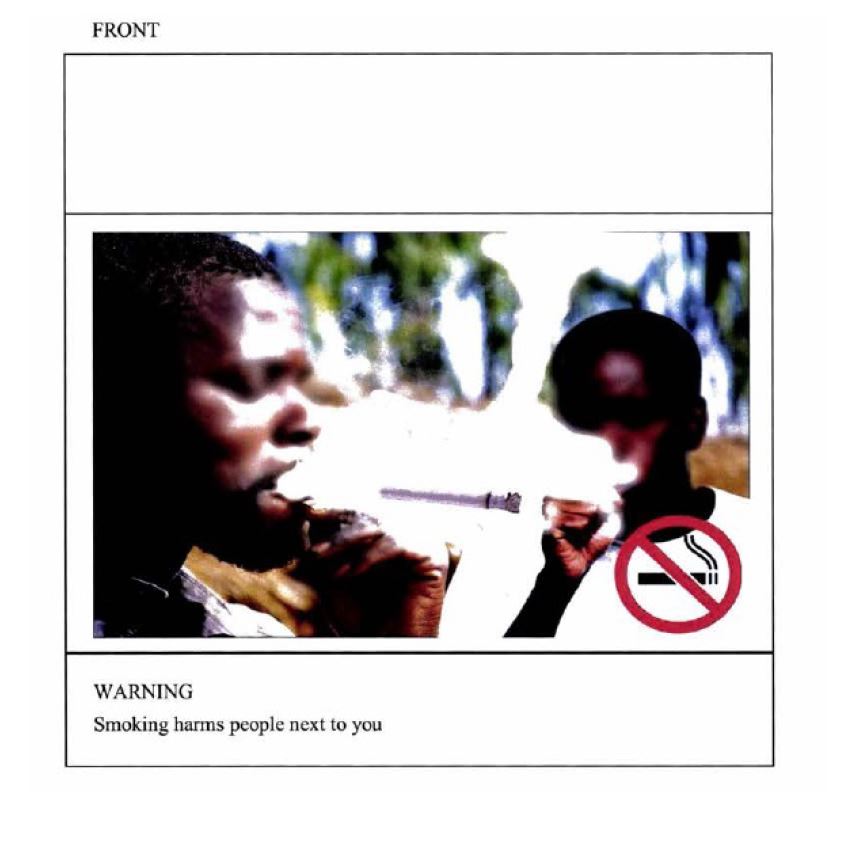
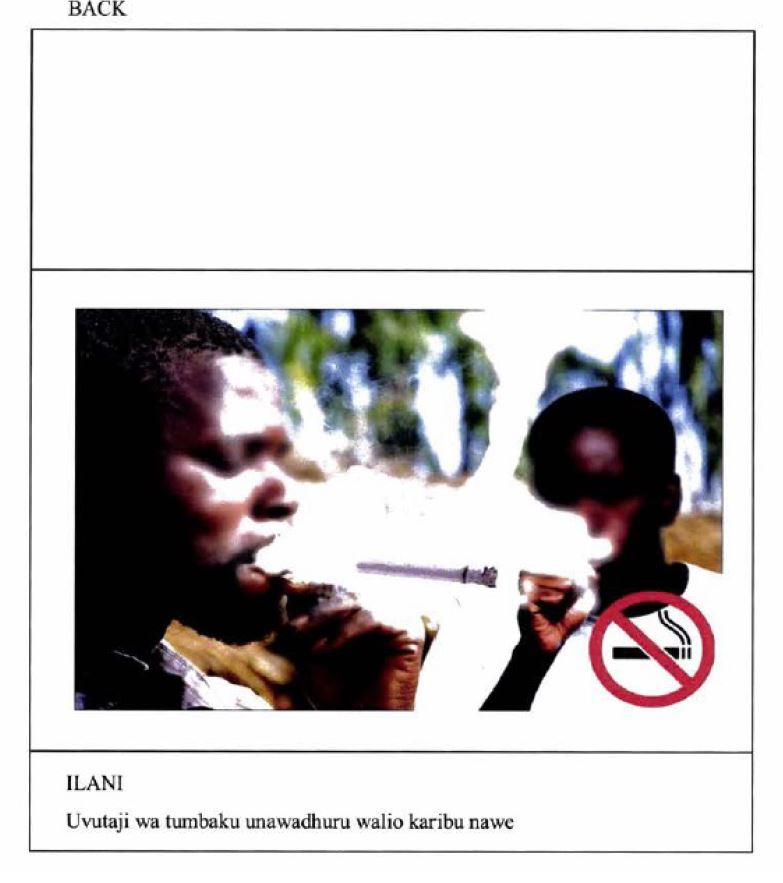
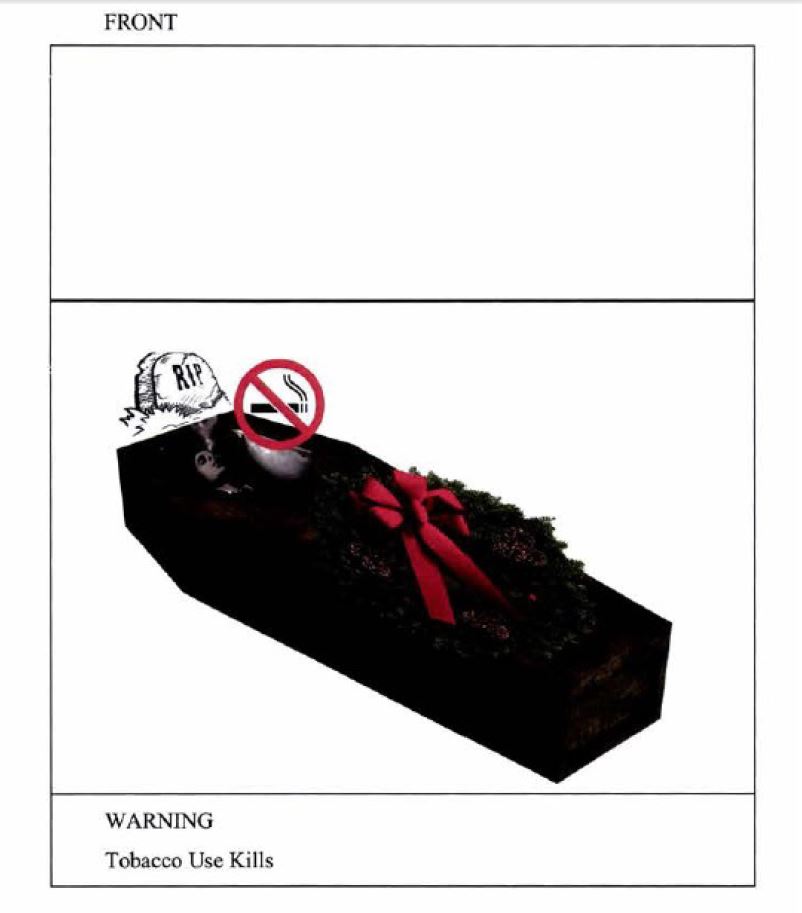

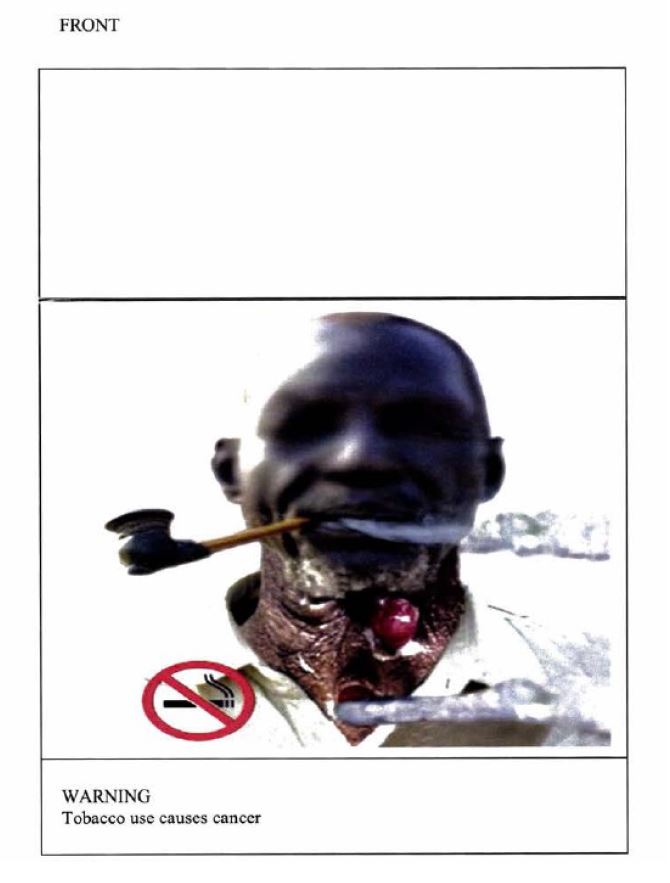
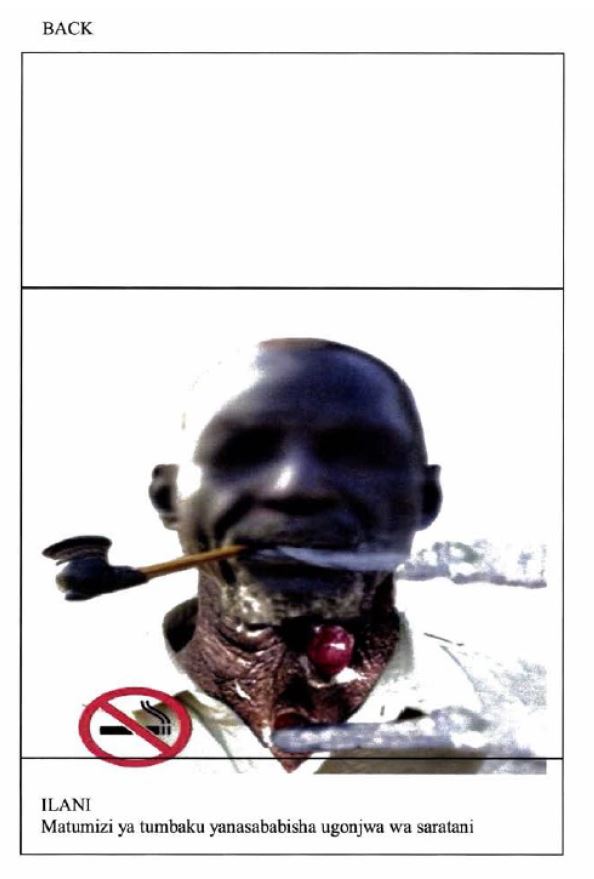
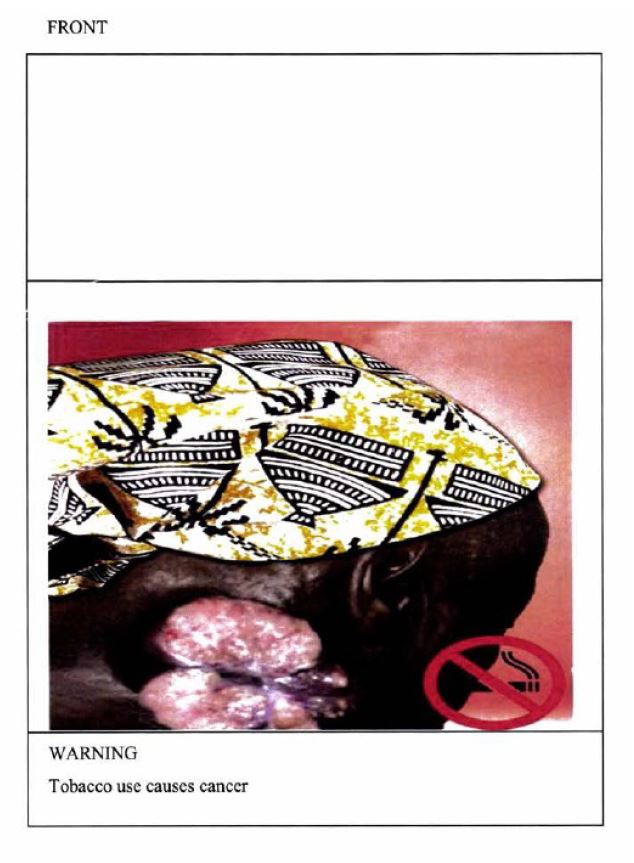
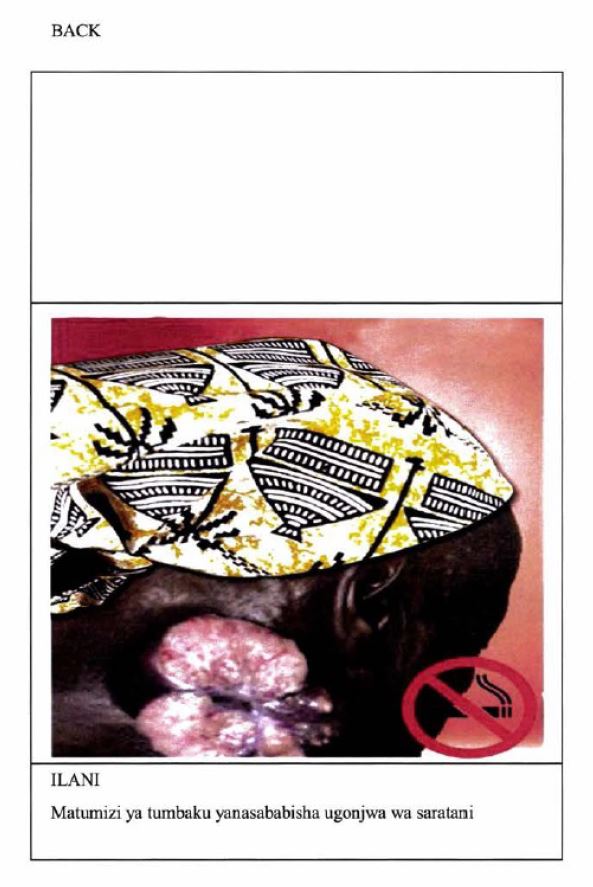
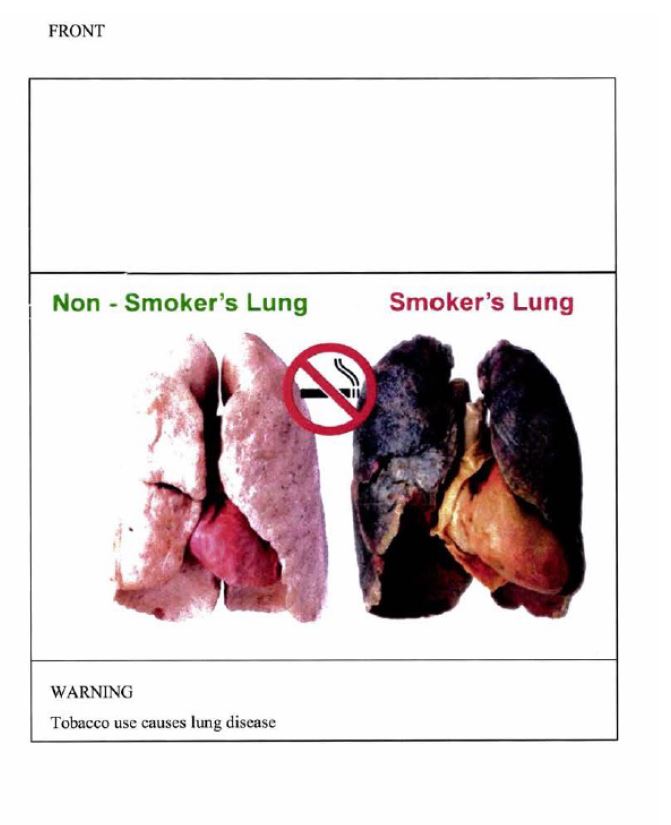

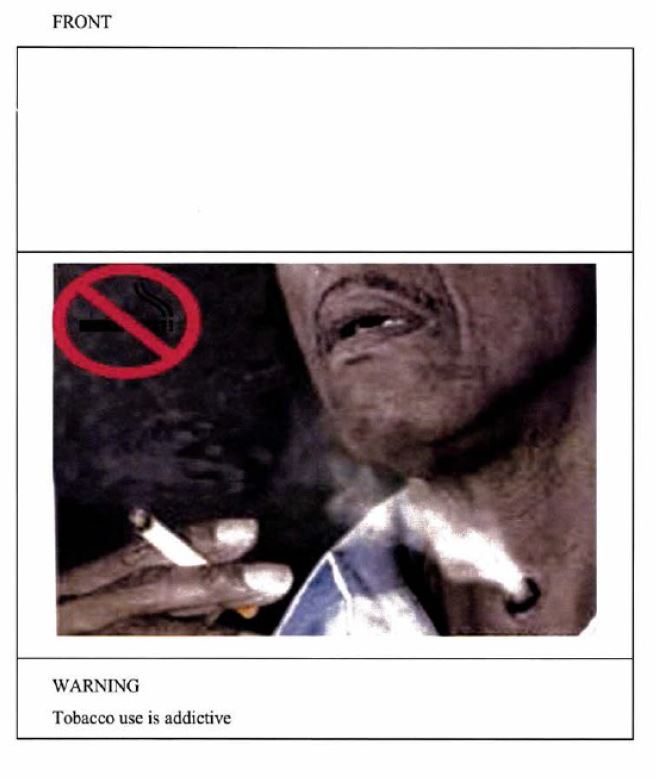

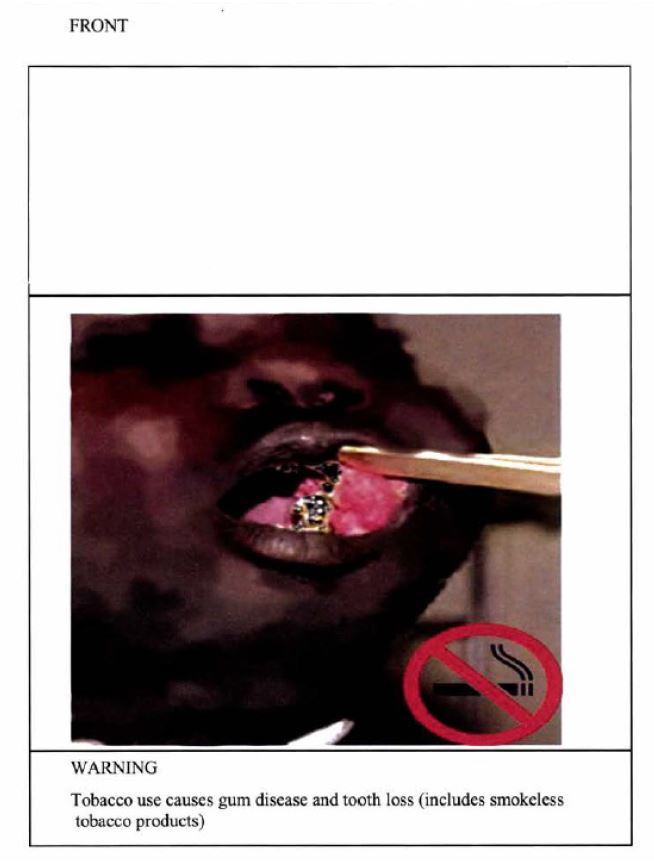
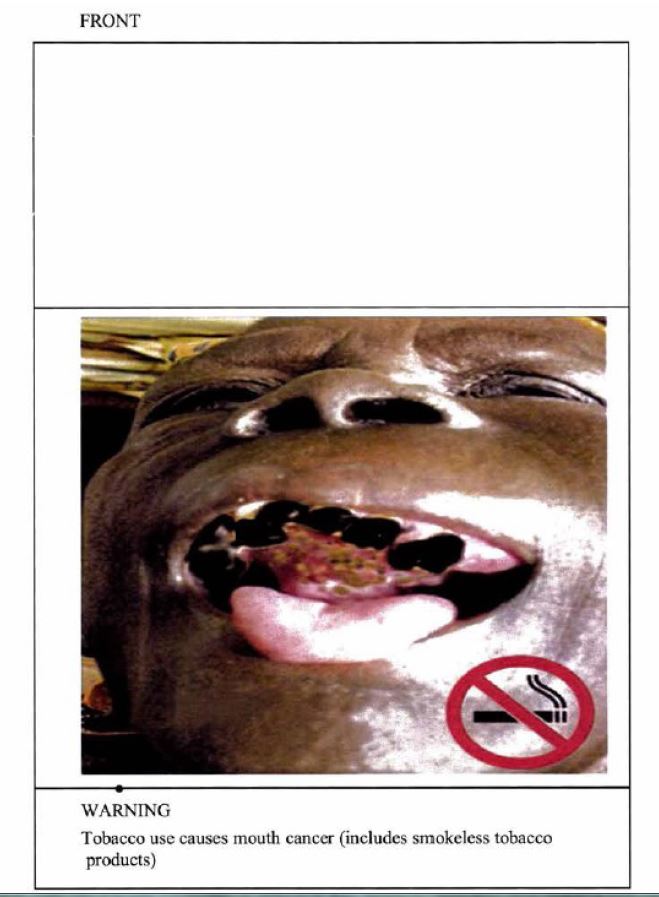
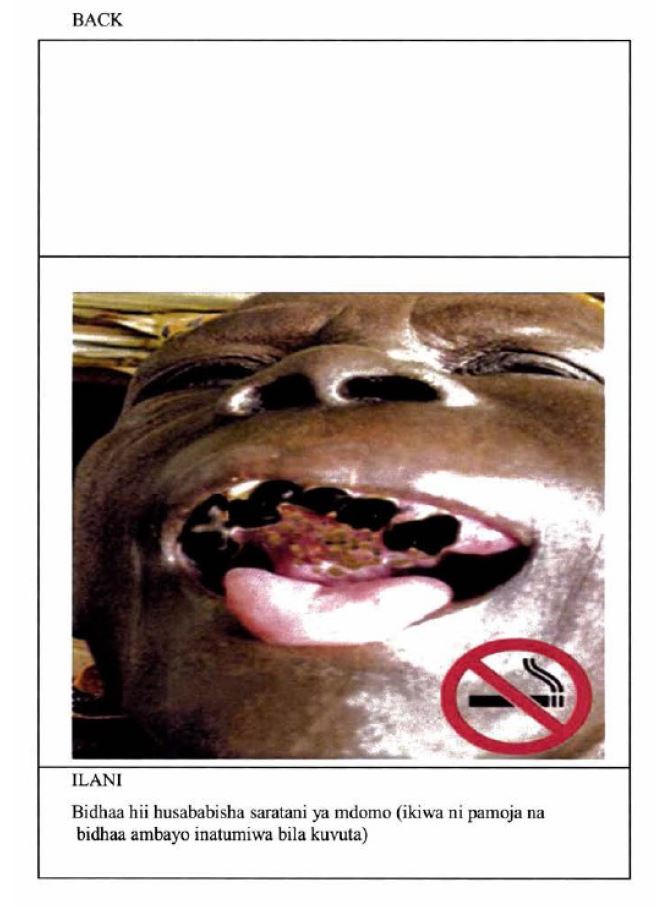
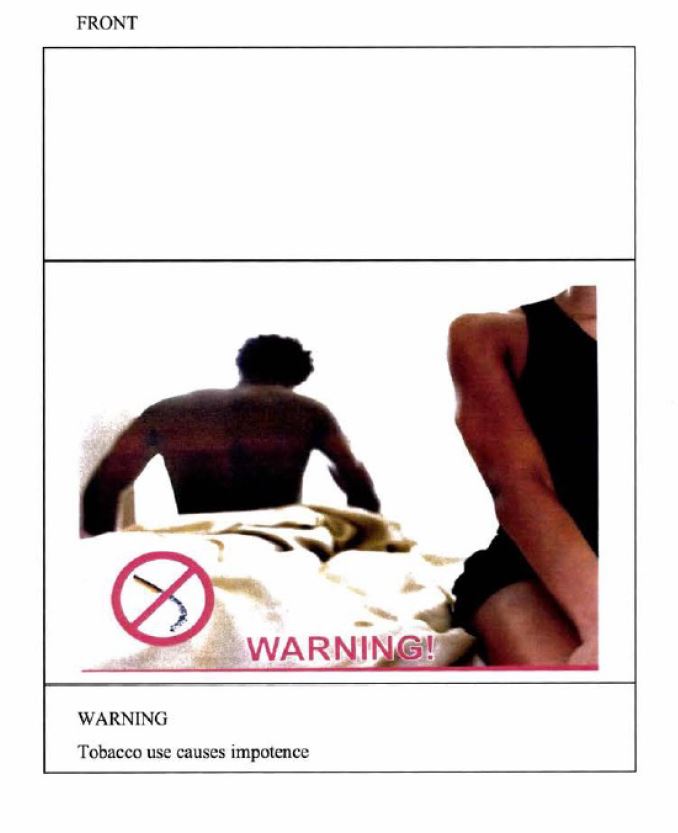


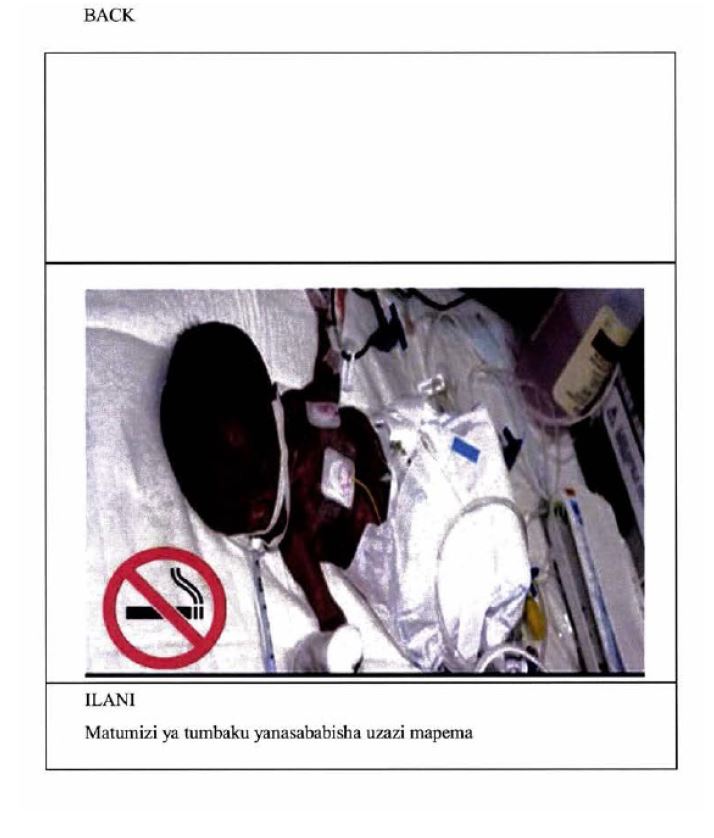
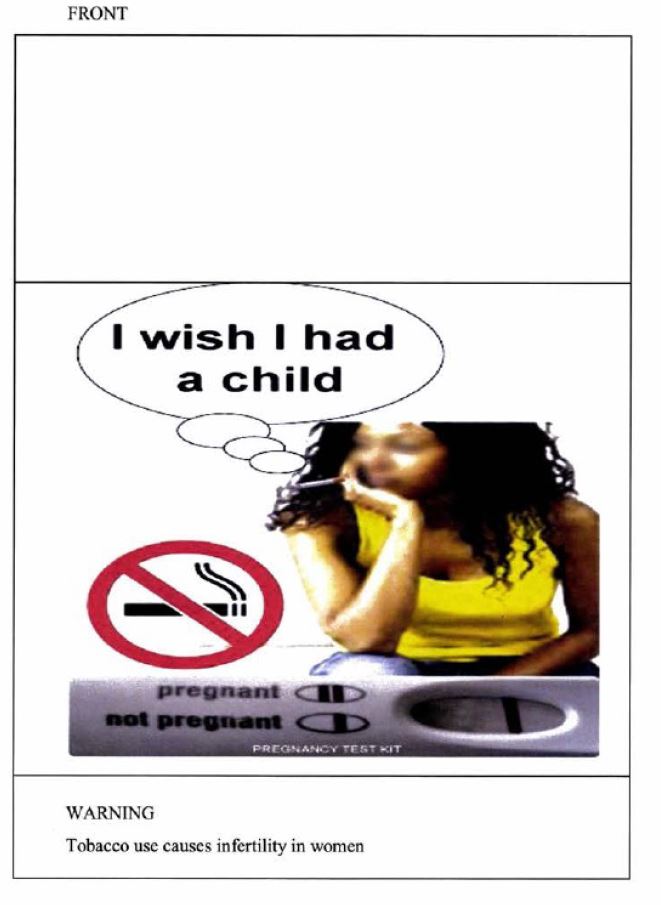
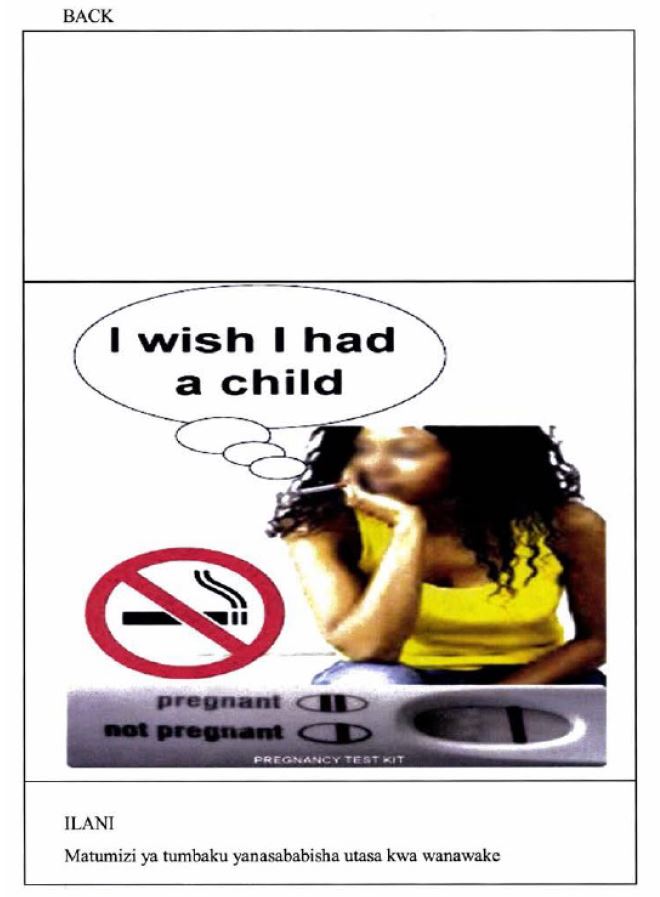



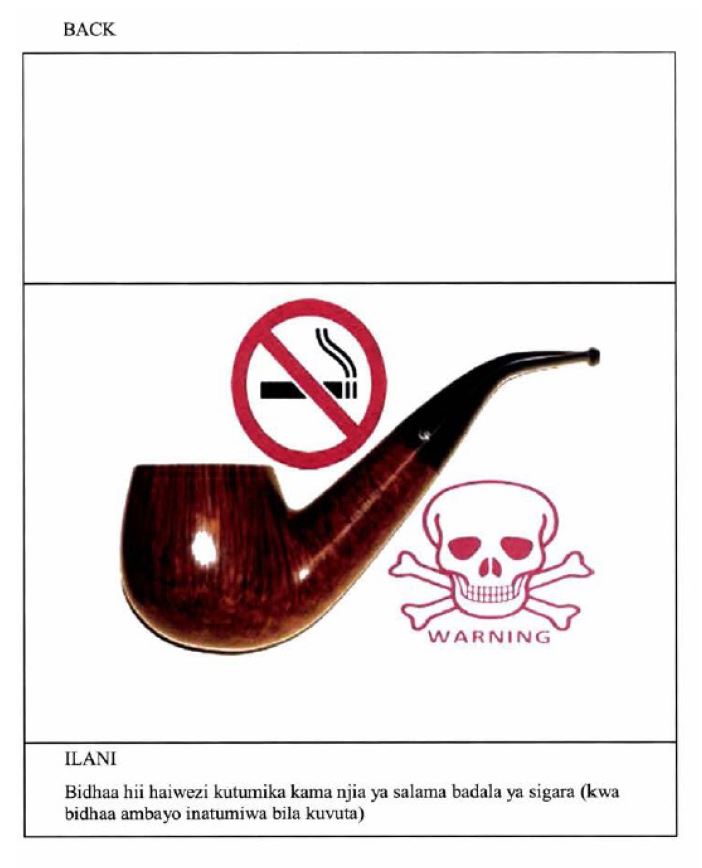
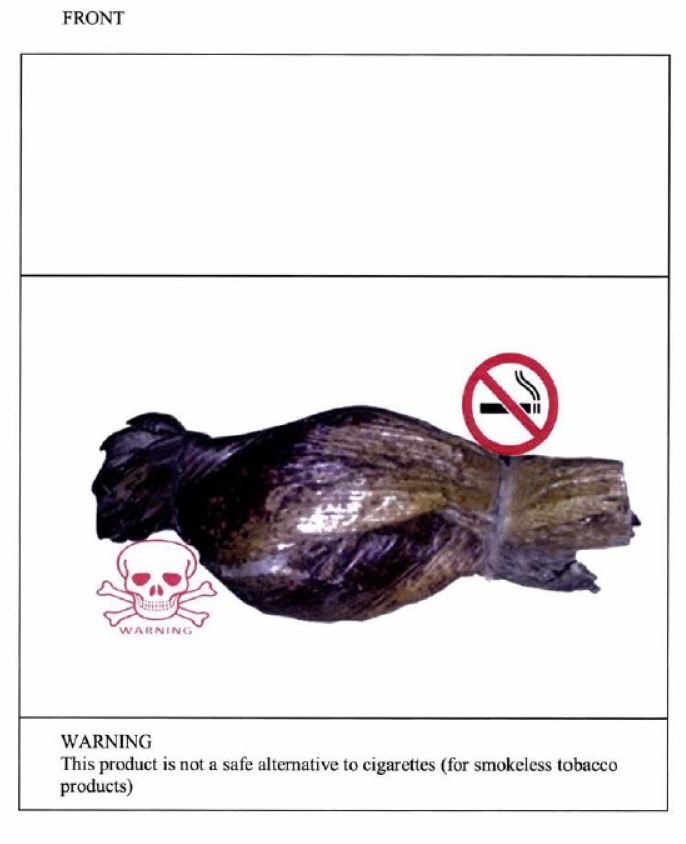
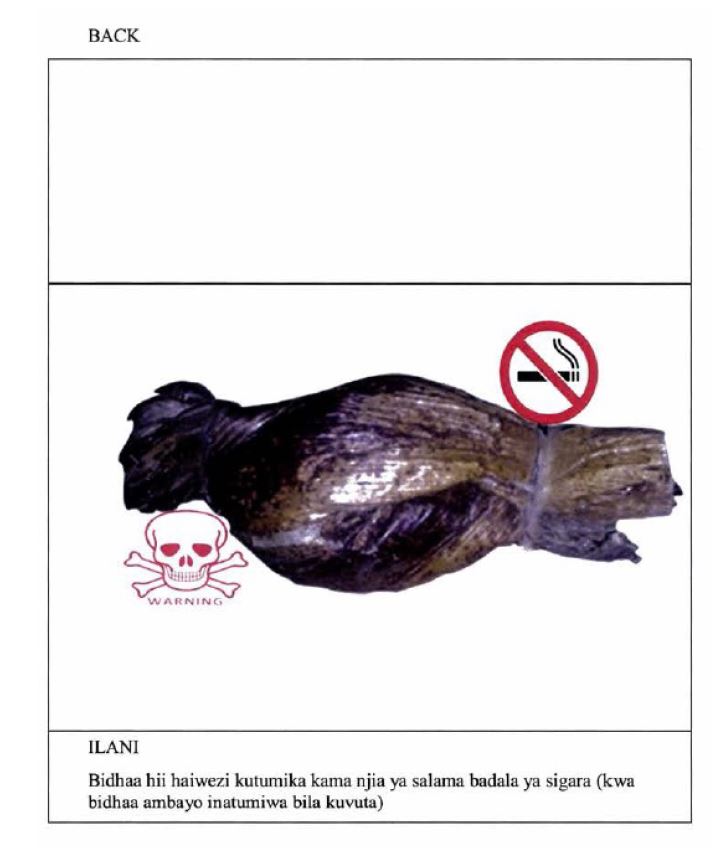

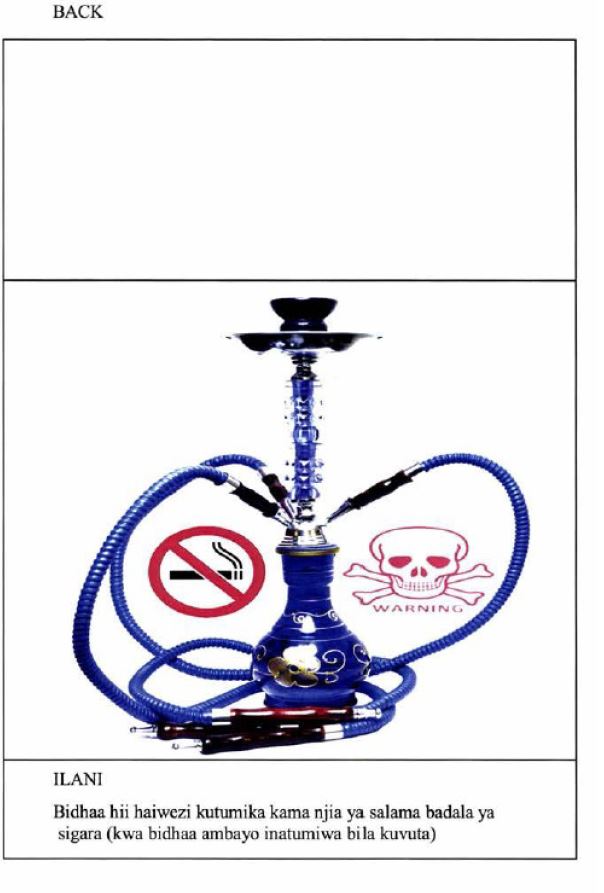

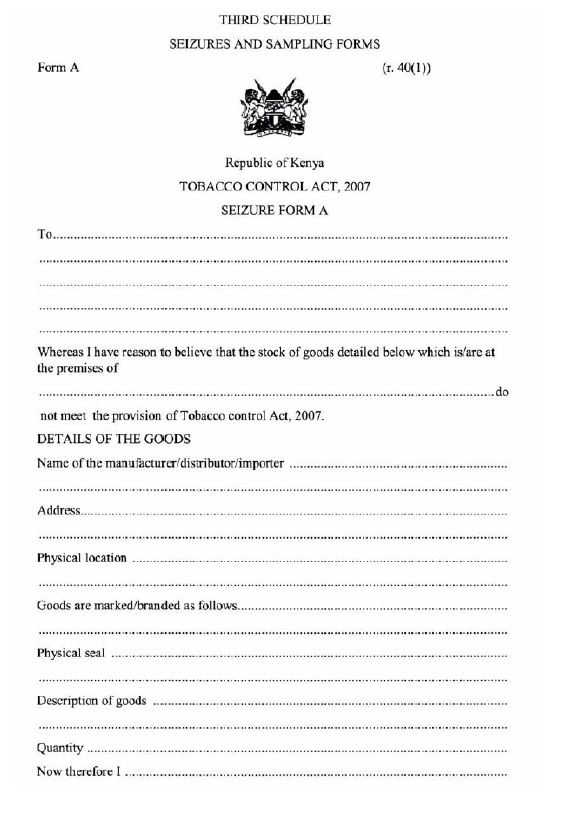

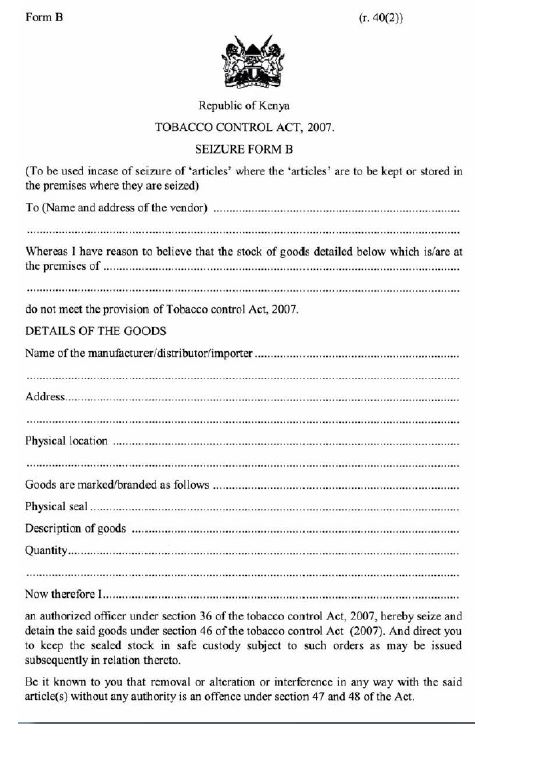
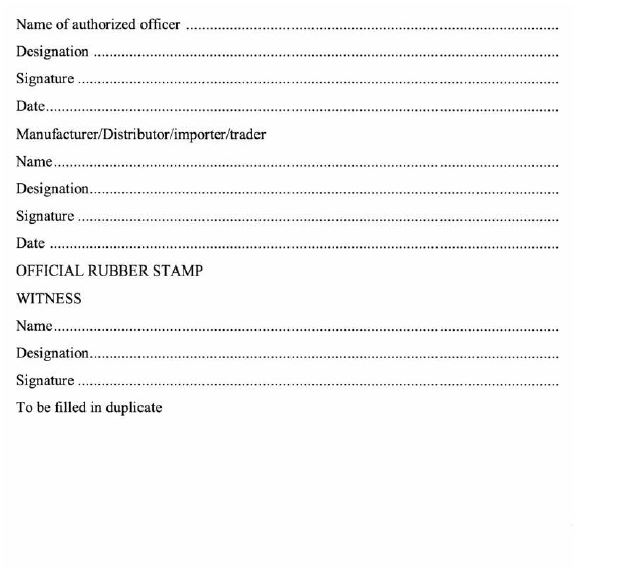
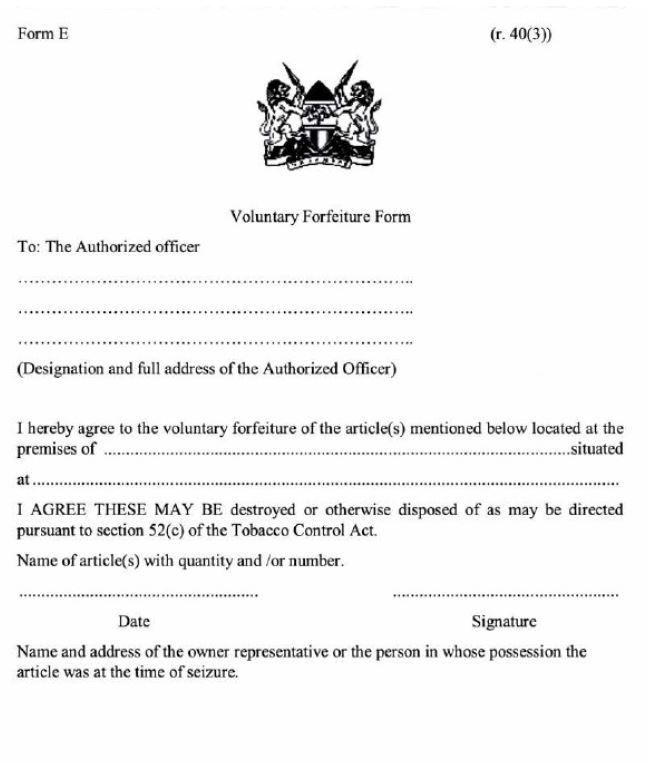
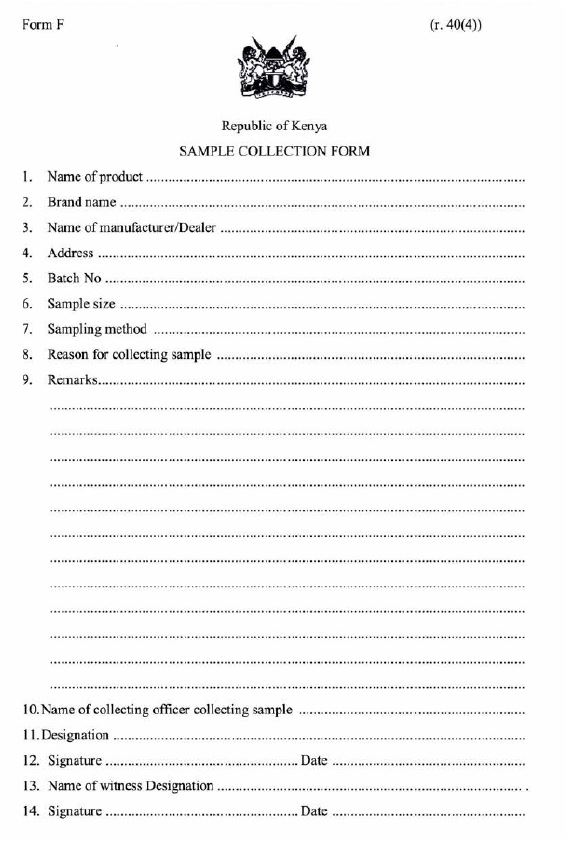
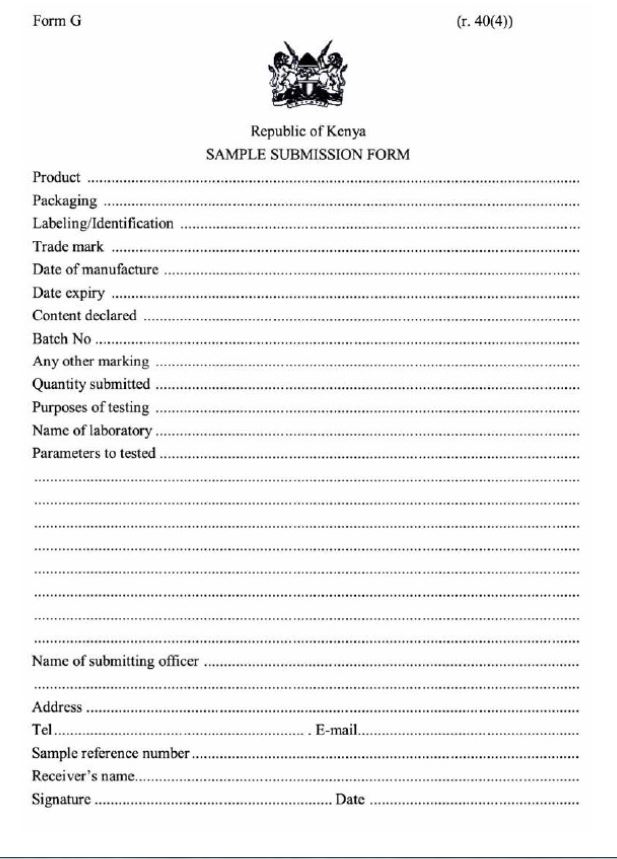
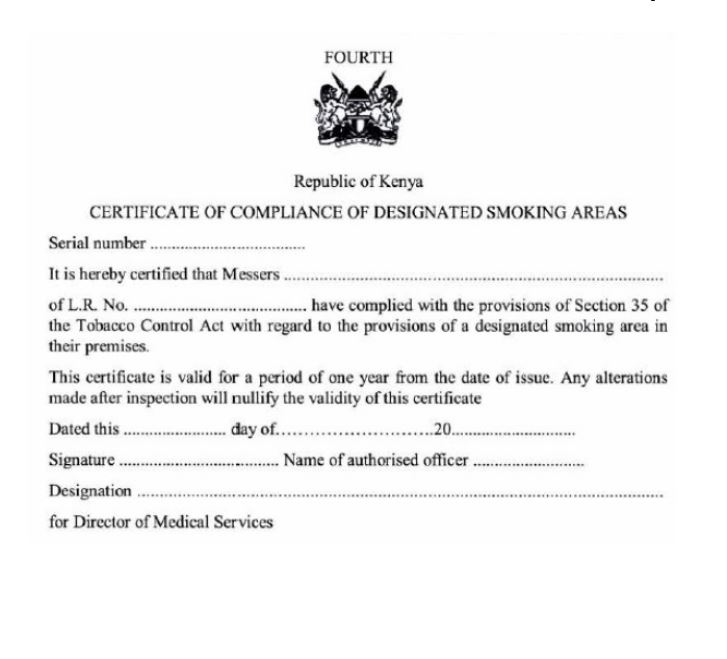
THE TOBACCO CONTROL REGULATIONS
PART I – PRELIMINARY
| 1. |
Citation and commencement
These Regulations may be cited as the Tobacco Control Regulations, 2014 and shall come into operation, upon the expiry of six months from the date of its publication in the Gazette.
|
| 2. |
Interpretation
In these Regulations, unless the context otherwise requires—
"Act" means the Tobacco Control Act (Cap. 245A);
"exposure" means the subjection of a person to an environment where smoking is taking place, has taken place or that contains the remains of any used tobacco product including, among others, cigarette stubs;
"financial year" means the period of twelve months ending on the 30th of June in each year;
"health warnings and messages" means the health warnings and messages referred to in section 21 and the Schedule to the Act and such other health messages as may be specified by the Cabinet Secretary from time to time;
"partially covered" means any space covered by a roof or enclosed by one or more walls or sides, regardless of the type of material used for the roof, walls or sides and regardless of whether it is permanent or temporary;
"point of sale" means any place where tobacco products are distributed, or sold as wholesale or retail;
"predominant local language" means any other language that is not a national language but is commonly used by the majority of the population residing in a particular area;
"principal display area" includes in the case of—
| (a) |
box type packages, two equal sized largest surface areas of the box that may be displayed or visible under normal conditions of sale or use;
|
| (b) |
pouch type packages, the entire surface area of the pack that may be displayed or visible under normal conditions of sale or use;
|
| (c) |
conical or cylindrical type of packages, the entire curved area of the pack that may be displayed or visible under normal conditions of sale or use;
|
| (d) |
any other form or type of package, the entire surface area of the pack that may be displayed or visible under normal conditions of sale or use;
|
"second-hand smoke" means smoke emitted from the burning end of a cigarette or any other tobacco products in combination with the smoke exhaled by the smoker;
"pictures or pictograms" means such graphics as are specified under these Regulations or as the Cabinet Secretary may from time to time specify;
"workplace" means any place used by people in their employment or work and all attached or associated places including vehicles used in the course of employment, geriatric homes and residential houses.
|
PART II – PACKAGING AND LABELING
| 3. |
Health warnings and messages in pictures and pictogrms
| (1) |
A person who manufactures, sells, distributes or imports a tobacco product shall ensure that every package containing the tobacco product bears warning labels and information required under section 21 of the Act and specified in the Schedule to the Act and the corresponding pictures and pictograms set out in First Schedule.
|
| (2) |
The manufacturer, seller, distributor or importer of a tobacco product shall ensure that the health warning and message including a pictogram or picture required under paragraph (1) is not distorted or likely to be damaged, concealed, obliterated, removed or rendered permanently unreadable when the package on which it is printed is opened in the normal way.
|
| (3) |
A picture and pictogram required under paragraph (1) shall be in full colour with contrasting colours for the background in a manner that maximizes noticeability and legibility of elements of health warnings and messages in the approved layout and design.
|
|
| 4. |
Prohibition against dealing in devices used to cover, obscure etc Health messages
| (1) |
No person shall manufacture, sell, distribute, or import a tobacco product, device or any other thing that is intended to be used to cover, obscure, mask, alter, or otherwise detract from the display of specified health warnings and messages including pictures and pictograms under the Act or these Regulations.
|
| (2) |
A person shall not design the package or parts of the package, or accessories thereto, with an cover that may obscure the prescribed health warnings and messages including pictograms or pictures.
|
|
| 5. |
Health message to be on both wrapper and packet
Where the health warnings and messages including pictograms that are required to be printed on packages are likely to be obscured or obliterated by a wrapper on the package, the manufacturer, seller, distributor or importer of the tobacco product shall ensure that the health warnings and messages shall be printed on both the wrapper and the packet.
|
| 6. |
Rotation of specified health warnings and messages
| (1) |
The manufacturer, seller, distibutor or importer of a tobacco product shall ensure that the specified health warnings and messages including pictograms required under these Regulations are rotated in accordance with section 21(3) of the Act.
|
| (2) |
When an old set of health warnings and messages including pictures and pictograms are being replaced by a set of new ones, both sets may continue to be used during the transition period.
|
| (3) |
For the purposes of paragraph (1), the twelve month rotational period referred to in section 21(3) of the Act shall be a period of twelve months ending on the 31st December in each year.
|
|
| 7. |
Format of health warnings and messages
| (1) |
The health messages required under these Regulations on all packages shall be in the form of a text message specified in the Schedule to the Act and a prescribed pictorial message set out First Schedule.
|
| (2) |
The text of the health message on the front face of a package shall—
| (a) |
be printed in white on a black background;
|
| (b) |
be printed in the type face known as Helvetica, in uppercase and lower-case letters as set out in the Second Schedule;
|
| (c) |
| (ii) |
subject to paragraph (d), of the same font size throughout the message; |
| (iv) |
of normal and bold weight as set out in the Second Schedule; and |
| (v) |
of a size that makes the text as nearly as possible fill the background on which it is printed; and |
|
| (d) |
bear the word "WARNING" which shall be in type of a font size not greater than fifty per cent of the font size of the type used for the text message.
|
|
| (3) |
A warning message on the back face of a package shall be—
| (a) |
printed on a white background;
|
| (b) |
printed in the type face known as Helvetica, in upper-case and lower-case letters as set out in the Second Schedule;
|
| (c) |
| (ii) |
subject to paragraph (d), of the same font size throughout the message; |
| (v) |
of such a size that the text as nearly as possible fills the background on which it is printed; and |
|
| (d) |
the word "WARNING" which shall be in type of a font size not greater than fifty per cent of the font size of the type used for the text message.
|
|
| (4) |
The health message place on the front face of the package shall be in English and a Kiswahili version of the health message shall be placed on the back face of the package.
|
|
| 8. |
Prohibition on certain product descriptions
A person shall not manufacture, sell, distribute, or import a tobacco product, for sale in Kenya, whose package carries a name, brand name, text, trademark or pictorial or any other representation or sign which suggests that the tobacco product is less harmful to health than other tobacco products.
|
| 9. |
Product identification markings
| (1) |
The package of every tobacco product shall contain a code marking, whether by batch numbering or otherwise through which the place, the date of manufacture and country of origin may be determined.
|
| (2) |
A manufacturer shall, upon request, provide the Cabinet Secretary with such information as shall be required to enable the Cabinet Secretary interpret the code marking on a tobacco product for the purpose of any of the Cabinet Secretary's functions under the Act or these Regulations.
|
|
| 10. |
Technical Repository
The Cabinet Secretary shall maintain—
| (a) |
a technical repository containing the required pictures, pictograms, health warnings and messages as well as related technical information to facilitate the implementation of Act and these regulations; and
|
| (b) |
a digital storage device which shall have the required pictures and pictograms and guidance documents on the application of the pictograms under this Part which shall be available to any interested person.
|
|
| 11. |
Display of signs at point of sale
Any sign pursuant to section 16 of the Act shall—
| (a) |
bear the words ‘The sale of or the availing of a tobacco product to a person under the age of eighteen years is prohibited by law’;
|
| (b) |
be predominantly displayed at the point above the level of the counter, shelf or container from which these products are stored for sale or sold; and
|
| (c) |
bear a black border around it.
|
|
PART III – INFORMATION TO BE PROVIDED BY MANUFACTURERS AND IMPORTERS
| 12. |
Product disclosure
A manufacturer or importer shall, at the end of each calendar year, provide the Cabinet Secretary, for each type of tobacco product and for each brand manufactured or imported—
| (a) |
a list of all the ingredients that the tobacco product contains including the quantities of those ingredients per unit of tobacco product and ingredients present in tobacco product components such as filters, glue and papers for each brand;
|
| (b) |
a statement of the reasons for the inclusion of those ingredients which shall indicate for each ingredients—
|
| (c) |
all toxicological data available to the manufacturer concerning the ingredients of that tobacco product in the case of products intended to be burnt or unburnt or of products not intended to be burnt or unburnt which shall for each ingredient—
| (i) |
refer in particular to their effects on health; |
| (ii) |
include any effects produced in combination with any of the other ingredients of that product that are not produced by that ingredient alone; and |
| (iii) |
include any addictive effects. |
|
| (d) |
information on the characteristics of the tobacco leaves used including—
| (i) |
the type of tobacco leaves and percentage of each type used in the tobacco product; |
| (ii) |
the percentage of reconstituted tobacco used; |
| (iii) |
the percentage of expanded tobacco used; and |
| (iv) |
changes to tobacco product ingredients when any change is made; and |
|
| (e) |
any information concerning the renaming or discontinuation of any brand produced by the manufacturer within the preceding twelve months.
|
|
| 13. |
Industry dislosure
A manufacturer shall, at the end of every calendar year, submit a report to the Cabinet Secretary on—
| (a) |
the quantity of tobacco products produced in the immediately preceding calendar year;
|
| (c) |
sales made and revenues earned;
|
| (d) |
quantities exported where applicable; and
|
| (e) |
affiliated organizations and its agents or persons acting on its behalf.
|
|
| 14. |
Offence under this Part
A person who declares false information under this Part commits an offence.
|
PART IV – PROTECTION AGAINST EXPOSURE TO SECOND-HAND TOBACCO SMOKE
| 15. |
Prohibition of smoking in private vehicles and near public place
Pursuant to section 32 and without prejudice to section 33(1) of the Act on second-hand tobacco smoke, no person shall smoke in—
| (a) |
a private vehicle where children are on board; or
|
| (b) |
streets, walkways, verandas adjacent to a public place.
|
|
| 16. |
Notice on prohibited smoking area
A notice displayed pursuant to section 34 of the Act shall—
| (a) |
bear the word 'WARNING' in capital letters, in red colour on a white background and in Helvetica type font;
|
| (b) |
bear the words 'It is an offence to smoke in this premises' in black colour on a white background and followed by a no smoking sign composed of a black burning cigarette encircled in red as set out in the First Schedule;
|
| (c) |
bear the words 'Penalty, Kshs. 50,000/- or imprisonment for a term of 6 months or both' appearing at the bottom of the notice;
|
| (d) |
consist of at least A3 paper size;
|
| (e) |
be posted at the main entrance, other entrances and appropriate locations of a prohibited smoking area; and
|
| (f) |
have a black border around it.
|
|
| 17. |
Supervision of non-smoking area
The manager or owner of a prohibited smoking area shall—
| (a) |
ensure that ash trays and all other accessories used to consume tobacco products are removed from the area;
|
| (b) |
supervise observance of a smoke free environment;
|
| (c) |
take steps to discourage individuals from smoking on the premises including—
| (i) |
require a person not to smoke or to stop smoking in the area; |
| (ii) |
discontinue services to the person smoking in the area; |
| (iii) |
require a person to leave the premises; or |
| (iv) |
contact an authorized officer or law enforcement officer and authorities to enforce the law if a person refuses to comply. |
|
|
| 18. |
Certification of compliance on designated smoking area
The manager or owner of premises who intends to establish a designated smoking area in accordance with section 35 of the Act shall obtain a certificate of compliance from the Director of Medical Services in the form set out in the Fourth Schedule.
|
| 19. |
Technical repository
The Cabinet Secretary shall establish and maintain—
| (a) |
a technical repository of required No Smoking Warnings and any other related technical information to facilitate their printing; and
|
| (b) |
a digital storage devise with the required No Smoking Warnings and any other related technical information to facilitate their printing which shall be available to any interested person.
|
|
PART V – PUBLIC TOBACCO INDUSTRY INTERACTIONS
| 20. |
Interpretation
In this part—
"business" includes trade or profession;
"company" includes any body corporate;
"Conference of Parties", means the Conference of Parties established under Article 23 of the World Health Organization Framework Convention for Tobacco Control;
"director", in relation to a body corporate whose affairs are managed by its members, means a member of the body corporate;
"holding company" or "subsidiary company" have the meanings assigned to them under the Companies Act (Cap. 486), Customs and Excise Act (Cap. 472);
"interactions" means meetings, correspondences and other exchanges between public authorities and the tobacco industry or its affiliates that arise when public authorities meet in a common forum with the tobacco industry or its affiliates whether directly or through third parties;
"public authority" means a body or legal and natural persons whose functions are of a public nature and any person acting on behalf of a public authority and includes all bodies and persons whose ownership, funding and control vests in the State;
"public officer" has the meaning assigned to it under the Article 260 of the Constitution of Kenya, 2010;
"relevant contractual arrangement" means any contractual arrangement pursuant to which all or some of the affairs of a party to that arrangement, which is incorporated or otherwise organised outside Kenya, are conducted in accordance wholly or partly with the wishes of a company, incorporated in Kenya is also party directly or indirectly to the arrangement;
"senior officer" in relation to—
| (a) |
a body corporate, means a director, manager, secretary or other similar officer of the body corporate;
|
| (b) |
a partnership, means a partner or any person who has control or management of the business of the partnership;
|
"tobacco industry" means tobacco manufacturers, wholesale distributors, importers of tobacco products, tobacco growers and its associations and includes other entities representing them, tobacco industry lobbyists or persons working to further the tobacco industry's agenda;
"tobacco industry interference" means any commercial or vested interest on the tobacco industry that subvert or undermine development, implementation and enforcement of public health policies, measures and laws for tobacco control.
|
| 21. |
Application of Part
This Part shall apply to all interactions between public authorities and the tobacco industry.
|
| 22. |
Limitation on interaction
| (1) |
Any interactions between public authorities or public officers and the tobacco industry shall be limited to the extent strictly necessary for effective tobacco control and enforcement of relevant laws.
|
| (2) |
A minimum of two public officers shall be present in any interactions with the tobacco industry.
|
| (3) |
Before commencing any interaction with the tobacco industry, the public officers shall state, in writing, that the interaction does not imply an endorsement of tobacco industry practices and that no relationship, collaboration or partnership shall be construed whatsoever from the interaction.
|
| (4) |
Any public officer participating in any interaction with tobacco industry shall prepare a formal record of the interaction and submit to the relevant public authorities including the Cabinet Secretary on request.
|
| (5) |
Interactions with the tobacco industry initiated by a public authority at the national, regional, county, district, urban authority or local level shall take place in public venues determined by the public authority.
|
| (6) |
Interactions with the tobacco industry shall not take place within offices or other facilities of the tobacco industry except in the course of enforcing or ensuring compliance with the law.
|
| (7) |
A public authority or public officer shall not accept any offers of hospitality from the tobacco industry or its affiliates.
|
| (8) |
A public authority shall not accept any direct or indirect funding from the tobacco industry or endorse projects, which are funded directly or indirectly by the tobacco industry.
|
|
| 23. |
Disclosure
| (1) |
A public officer who has any interest, whether pecuniary or business, in the tobacco industry shall disclose the nature of the interests to the respective public authority, on commencement of employment and as soon as the relevant facts have come to his or her knowledge in accordance with the Public Officers Ethics Act (Cap. 185B).
|
| (2) |
A disclosure of interest under paragraph (1) shall be recorded by every public authority.
|
| (3) |
A public officer having made such disclosure shall subject to section 12 of the Public Officer Ethics Act (Cap. 185B), not under any circumstances—
| (a) |
be present during any interactions of the public authority with the tobacco industry;
|
| (b) |
take part in the decision making of the public authority relating to the tobacco industry;
|
| (c) |
be present during the deliberations of any public authority for the making of that determination; and
|
| (d) |
influence directly or indirectly any other member or decision making of the Public authority.
|
|
| (4) |
A person who contravenes this Regulation commits an offence.
|
|
| 24. |
Code of conduct
The Cabinet Secretary shall prescribe a code of conduct prescribing standards for any public officer including service providers, contractors consultants involved in setting or implementing public health policies for tobacco control.
|
| 25. |
Award of contracts
A public authority shall not award contracts for carrying out any work related to setting and implementing public health policies with respect to tobacco control to candidates or tenderers who have conflicts of interest with established tobacco control policies.
|
| 26. |
Disclosure on intention to engage with tobacco industry
A public officer who has or had a role in setting and implementing public health policies with respect to tobacco control shall—
| (a) |
inform the respective public authority where the person served, about any intention to engage in an occupational activity within the tobacco industry, whether gainful or not within a period of at least three years after leaving service; and
|
| (b) |
not engage in such occupational activity within a period of three years from the time the persons ceases being a public officer.
|
|
| 27. |
Disclosure of prior engagement with tobacco industry
A person applying for a public office which has a role in setting and implementing public health policies regarding tobacco control shall declare any current or previous occupational activity with any tobacco industry whether gainful or not.
|
| 28. |
Public Officer to declare and divest interests
A public officer who has a role in setting and implementing public health policies with respect to tobacco control shall declare interest in the tobacco industry to the Cabinet Secretary and divest himself or herself of direct interests in the tobacco industry.
|
| 29. |
Prohibition on participation as delegate in Conference of Parties
A person employed by the tobacco industry or any setting working to further the interests of the tobacco industry shall not serve on Kenyan delegations to meetings of the Conference of Parties, its subsidiary bodies or any other bodies established pursuant to decisions of the Conference of the Parties.
|
| 30. |
Prevention of interference
A public authority shall—
| (a) |
promote tobacco control and prevent tobacco industry interference within its mandate, plans and activities;
|
| (b) |
adopt mechanisms to raise awareness within its mandate about the interference and vested interests of tobacco industry with the development and enforcement of tobacco control legislations and policies;
|
| (c) |
not accept, support or endorse partnerships, sponsorships, services and any monetary or non-monetary assistance from the tobacco industry except for compensations due to legal settlements or as mandated by applicable law;
|
| (d) |
not enter into or endorse non-binding or non-enforceable agreements or any voluntary arrangement or joint tobacco control and other activities with the tobacco industry;
|
| (e) |
not accept, support or endorse the tobacco industry organizing, promoting, participating in, or performing, children, youth or public education or any initiatives that are directly or indirectly related to tobacco control;
|
| (f) |
not endorse, support, form partnerships with or participate in activities of the tobacco industry described as corporate social responsibility;
|
| (g) |
restrict involvement of tobacco industry in the development of tobacco control policies and laws except in public forums where the industry is presenting its views to the public authority on relevant tobacco control laws and polices;
|
| (h) |
not allow any person employed by the tobacco industry or any entity working to further its interests to be a member of any government body, committee or advisory group that sets or implements tobacco control or public health policy.
|
|
| 31. |
Prohibition of monetary and non-monetary gifts
| (1) |
Any entity which is part of the tobacco industry shall not grant any monetary and non-monetary payments, gifts and services to public authorities or a public officer.
|
| (2) |
A public authority or officer shall not receive any monetary or non monetary payment, gift or favour from tobacco industry.
|
| (3) |
A public authority or officer who contravenes this Regulation commits an offence.
|
|
| 32. |
No preferential treatment of tobacco industry
A public authority shall not grant incentives, privileges, benefits or any other preferential treatment to the tobacco industry to establish or run their businesses.
|
| 33. |
Upholding of public health policies
| (1) |
A public authority shall, while implementing investment and tax laws and other policies related to tobacco, be guided by the priority to tackle the adverse health, social, economic and environmental impacts of tobacco growing, manufacture, sale and consumption in Kenya.
|
| (2) |
The Cabinet Secretary for the time being responsible of agriculture shall pursuant to section 13(1) of the Act put in place policies to promote appropriate, economically viable alternatives for tobacco growers.
|
|
| 34. |
Annual reports of public authorities
| (1) |
Every public authority involved in tobacco control shall, at the end of every calendar year, prepare and submit an annual report on the implementation of this Part to the Board.
|
| (2) |
A report prepared and submitted pursuant to paragraph (1) shall specify—
| (a) |
the measures undertaken during that period to implement this part;
|
| (b) |
the achievements and shortcomings relating to implementation of this part and actions proposed to improve performance in furtherance of this part;
|
| (c) |
any lobbying, philanthropy, political contributions and all other activities by the tobacco industry;
|
| (d) |
any business and non-business partners and supporters of tobacco industry involved with the public authority;
|
|
| (3) |
The Board shall review the reports submitted pursuant to paragraph (1) and advise the Cabinet Secretary on the measures that may need to be adopted by the respective public authority to ensure comprehensive and effective implementation of this Part.
|
|
| 35. |
Offences of subverting tobacco control and related public health policies
A public officer commits an offence under the Act if the officer offers, promises or gives financial or other advantage to another public officer with the intention of—
| (i) |
inducing the public officer to improperly perform a function or activity under this Regulation; or |
| (ii) |
rewarding the public officer for the improper performance of any function or activity. |
|
| 36. |
Offences committed by tobacco industry
| (1) |
A person performing services for or on behalf of a tobacco company or its affiliate, a commercial organization or other corporate body who, in connection with the business of the tobacco industry, subverts or was negligent in failing to prevent the subversion of a tobacco control and related public health policy commits an offence.
|
| (2) |
These Regulations apply if the offence is proved to have been committed with the consent or connivance of a senior officer of the body corporate or a person purporting to act in such a capacity, that person as well as the body corporate commits an offence.
|
|
PART VI – TOBACCO CONTROL FUND
| 37. |
Solatium contribution
The solatium compensatory contribution payable under section 7(2)(f) of the Act in every financial year shall be the sum of two per cent of the value of the tobacco products manufactured or imported by the manufacturer or importer in that financial year.
|
| 38. |
Forfeiture of property
| (1) |
The Cabinet Secretary may direct that the property forfeited to the State under section 52 of the Act, be transmitted to the Fund for disposal.
|
| (2) |
The Officer Administering the Fund shall, upon the direction under paragraph (1), take possession of the property and make arrangements to dispose of the property in accordance with the Public Procurement and Disposal Act (Cap. 412C).
|
| (3) |
All proceeds realized from the sale of the property under this regulation shall form part of the Fund.
|
|
PART VII – ENFORCEMENT
| 39. |
Authorized Officers and Responsible Persons
In addition to section 36 of the Act, an authorized officer includes Medical Officer of Health, customs officers, police officers and administration police officers, prisons officers and local authority inspectorate officers, Kenya forest rangers.
|
| 40. |
Forms
| (1) |
Authorized officers shall use form A set out in the Third Schedule for the purposes of seizing any tobacco product pursuant to section 46 of the Act.
|
| (2) |
Where an authorized officer effects a seizure and stores any tobacco products in the same premises, the officer shall use form B set out in the Third Schedule.
|
| (3) |
Where a product has been seized pursuant to section 46 of the Act and the owner, manufacturer, importer, distributor, dealer, of the seized tobacco products shall forfeit ownership to the State for destruction or disposal using form E set out in the Third Schedule.
|
| (4) |
In discharging the powers conferred under section 37 and 38, an authorized officer shall collect samples of tobacco products using form F set out in the Third Schedule and forward the sample to an accredited and designated government laboratory for analysis using form G set out in the Third Schedule.
|
|
PART VIII – MISCELLANEOUS PROVISIONS
| 41. |
Public hearings
The Board shall convene annual public hearings at the national and county level to receive reports, public views and comments from any interested persons on matters related to the implementation of the Act.
|
| 42. |
Access to information
The Cabinet Secretary shall ensure that all information, reports and documents related to the implementation of the Act are accessible to the public.
|
| 43. |
Monitoring and Reporting
| (a) |
monitor the implementation of the Act; and
|
| (b) |
every financial year, prepare and submit to the cabinet Secretary, an annual status report on the implementation of the Act.
|
|
| 44. |
Public reporting
| (1) |
Every public authority involved in tobacco control shall establish mechanisms to enable any person to report the contravention of the Act and these Regulations and expeditiously take action in accordance with these Regulations.
|
| (2) |
No disciplinary or other adverse actions shall be instituted against any person who reports the contravention as required by these Regulations.
|
|
| 45. |
Offences and general penalty
| (1) |
Any person who contravenes or facilitates the contravention of these Regulations commits an offence punishable under the Act.
|
| (2) |
Any person who contravenes any provisions of these Regulations commits an offence and is liable, on conviction to a fine not exceeding five hundred thousand shillings or to imprisonment for a term not exceeding three years.
|
|
FIRST SCHEDULE [r. 3(1), 7(1), 16]
LIST OF PRESCRIBED HEALTH WARNINGS AND MESSAGES INCLUDING CORRESPONDING PICTOGRAMS
The following health warnings and corresponding pictograms shall, in addition to the messages set out in the Schedule to the Act, be displayed on every package containing a smokeless tobacco product as provided for under Section 21 (3) of the Act
This Product can cause gum diseases and tooth loss
This product causes mouth cancer
This product is not a safe alternative to cigarettes
Health messages and pictorials on packages
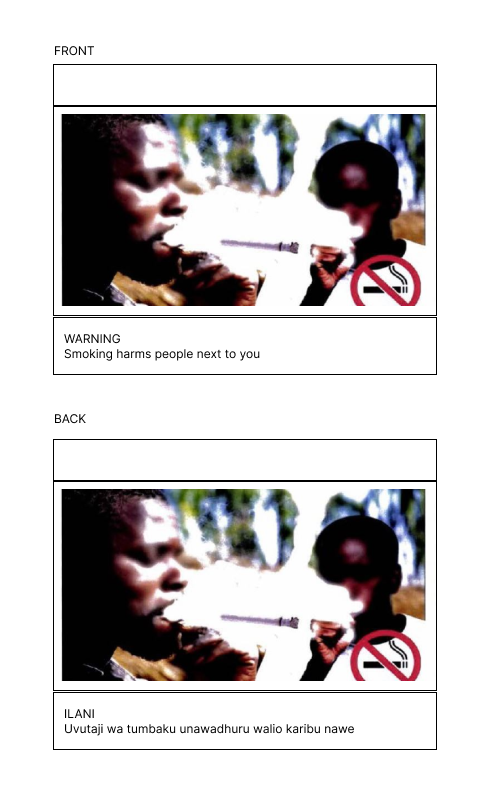
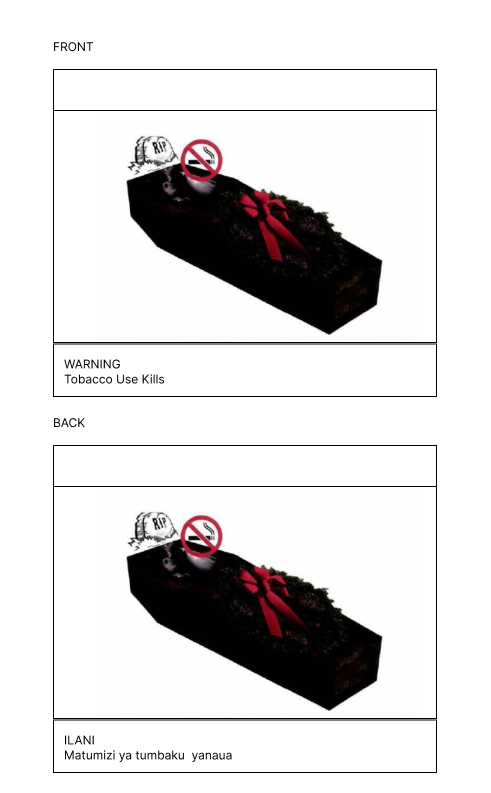



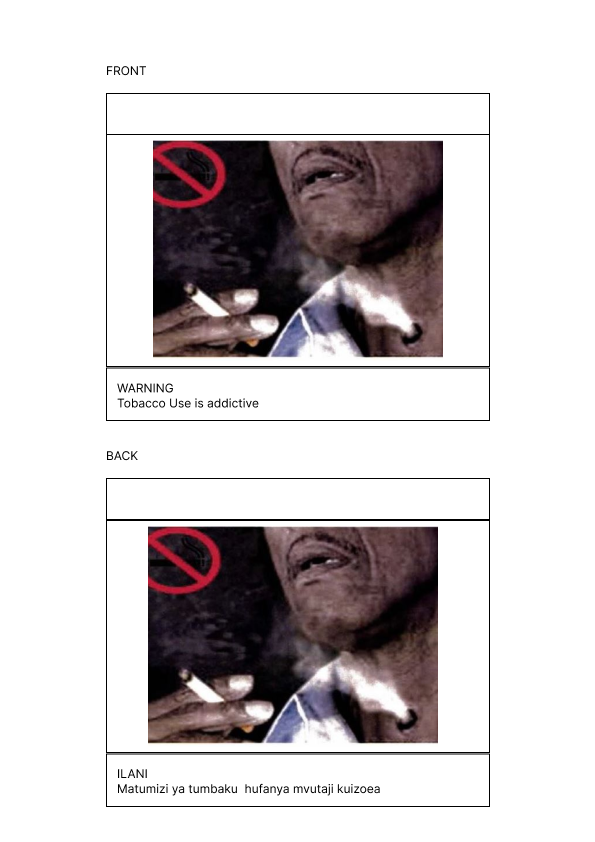


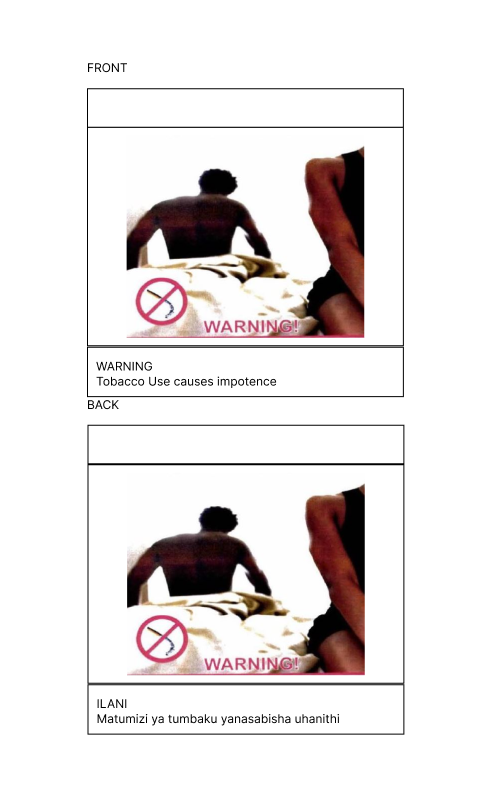
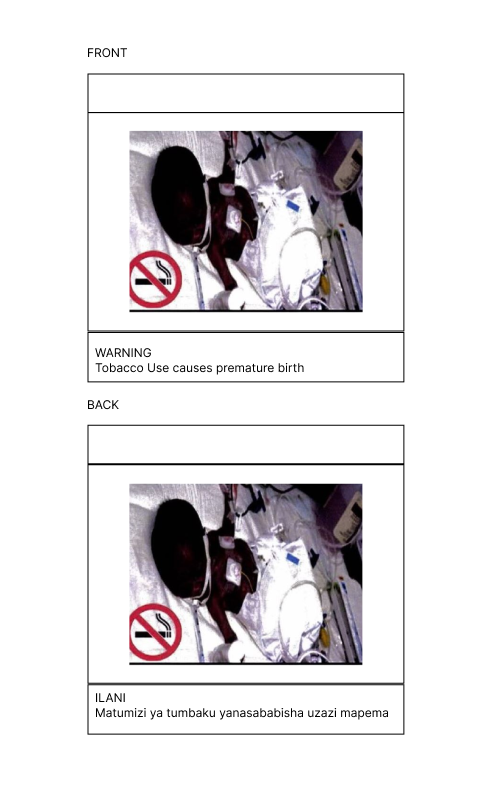
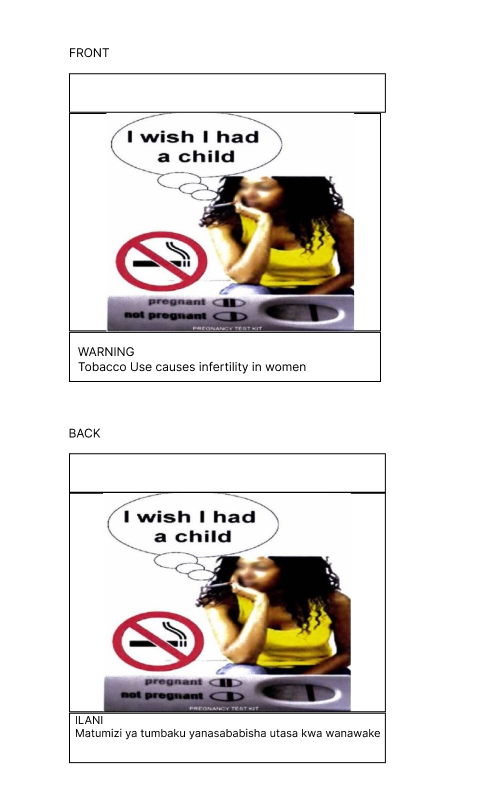




SECOND SCHEDULE [r.7 (2)(b), 7(2)(c),7(3)]
HEALTH WARNINGS FOR DISPLAY
|
|
WARNING
|
|
|
Sale of tobacco products to any person under the age of eighteen (18) years is prohibited by lawTobacco Control Act 2007 (Sec. 16)TOBACCO KILLS
|
|
|
ILANI
|
|
|
Uuzaji wa bidhaa za tumbaku kwa mtu yeyote aliye chini ya umri wa miaka kumi na minane (18) ni marufukuSheria ya udhibiti tumbaku ya 2007 (Kif.na. 16)Tumbaku inaua
|
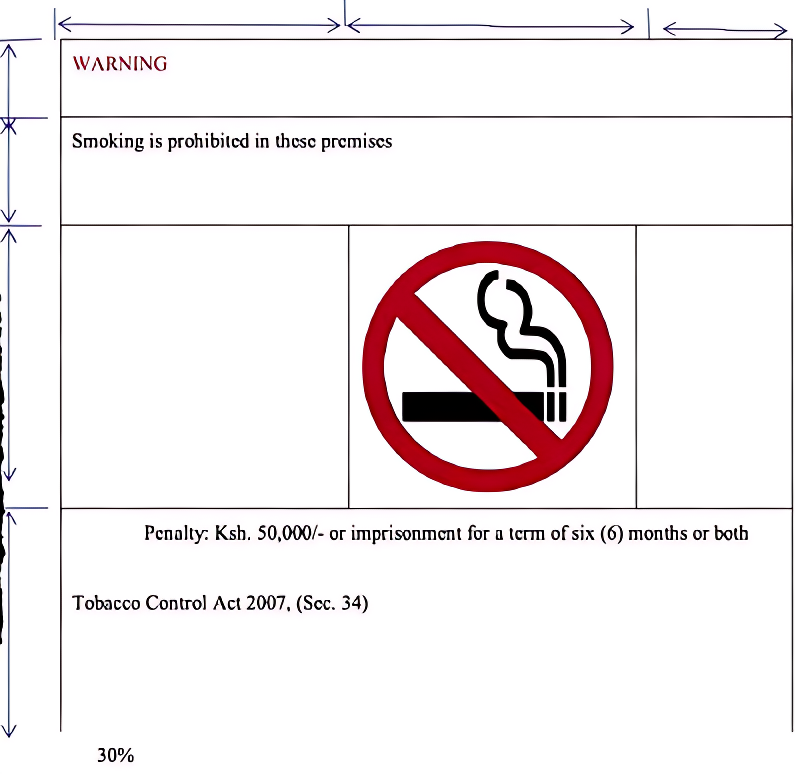
THIRD SCHEDULE
SEIZURES AND SAMPLING FORMS
TOBACCO CONTROL ACT, 2OO7
To .............................................
................................................
................................................
Whereas I have reason to believe that the stock of goods detailed below which is/are at the premises of ......... do not meet the provision of Tobacco control Act, 2007.
DETAILS OF THE GOODS
Name of the manufacturer/distributor/importer ..............................
Address ......................................................
Physical location ......................................................
Goods are marked/branded as follows ...................................
Physical seal ......................................................
Description of goods ......................................................
Quantity ......................................................
Now therefore I ......................................... an authorized officer under section 36 of the tobacco control Act(2007), hereby seize and detain the said goods under section 46 of the tobacco control Act (2007).
Name of authorized officer ....................................
Designation ...................................................
Signature ......................................................
Date ......................................................
Manufacturer/Distributor/importer/trader
Name ......................................................
Designation ...................................................
Signature .......................... Date ...............................
OFFICIAL RUBBER STAMP
WITNESS
Name ......................................................
Designation ...............................................
Signature .................................................
To be filled in duplicate.
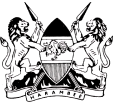
TOBACCO CONTROL ACT, 2OO7
(To be used incase of seizure of'articles' where the 'articles' are to be kept or stored in the premises where they are seized)
To (Name and address of the vendor) ......................................................
Whereas I have reason to believe that the stock of goods detailed below which is/are at
the premises of ..................................... do not meet the provision of Tobacco control Act, 2007.
DETAILS OF THE GOODS
Name of the manufacturer/distributor/importer ..............................
Address ......................................................
Physical location ......................................................
Goods are marked/branded as follows ......................................................
Physical seal ......................................................
Description of goods ......................................................
Quantity ......................................................
Now therefore I ......................................... an authorized officer under section 36 of the tobacco control Act, 2007 , hereby seize and detain the said goods under section 46 ofthe tobacco control Act (2007). And direct you to keep the sealed stock in safe custody subject to such orders as may be issued subsequently in relation thereto.
Be it known to you that removal or alteration or interference in any way with the said article(s) without any authority is an offence under section 47 and 48 of the Act.
Name of authorized officer ......................................................
Designation ......................................................
Signature ......................................................
Date ......................................................
Manufacturer/Distributor/importer/trader
Name ......................................................
Designation ......................................................
Signature .............................
Date .....................................
OFFICIAL RUBBER STAMP
WITNESS
Name ......................................................
Designation .............................................
Signature .................................................
To be filled in duplicate.

Voluntary Forfeiture Form
To: The Authorized officer
................................................
................................................
................................................
(Designation and full address of the Authorized Officer)
I hereby agree to the voluntary forfeiture of the article(s) mentioned below located at the premises of ......................... situated at .................
I AGREE THESE MAY BE destroyed or otherwise disposed of as may be directed pursuant to section 52(c) ofthe Tobacco Control Act.
Name of article(s) with quantity and /or number.
|
.....................................................Date
|
.....................................................Signature
|
Name and address of the owner representative or the person in whose possession the article was at the time of seizure.

l. Name of product .....................................................
2. Brand name .....................................................
3. Name of manufacturer/Dealer .................................
4. Address .....................................................
5. Batch No .....................................................
6. Sample size .....................................................
7. Sampling method .....................................................
8. Reason for collecting sample ..................................
9. Remarks .......................................................................................................
...................................................................................................................
...................................................................................................................
..................................................................................................................
..................................................................................................................
1O. Name of collecting officer collecting sample .....................
11. Designation ..................................
12. Signature.......................... Date ..........................
13. Name of witness Designation ..................................
14. Signature.......................... Date ..........................

Product .....................................................
Packaging .....................................................
Labeling/Identification ......................................
Trade mark .....................................................
Date of manufacture ............................................
Date expiry .....................................................
Content declared .....................................................
Batch No .....................................................
Any other marking .....................................................
Quantity submitted .....................................................
Purposes of testing .....................................................
Name of laboratory .....................................................
Parameters to tested .....................................................
...........................................................................
...........................................................................
...........................................................................
.....................................................
Name of submitting officer .....................................................
Address .....................................................
Tel .............................................. E-mail ....................................
Sample reference number .....................................................
Receiver's name .....................................................
Signature ..................................... Date ...................................
FOURTH SCHEDULE
CERTIFICATE OF COMPLIANCE OF DESIGNATED SMOKING AREAS
Serial number ...................................
It is hereby certified that Messers ................................. of L.R No. ................... have complied with the provisions of Section 35 of the Tobacco Contol Act with regard to the provisions of a designated smoking area in their premises.
This certificate is valid for a period of one year from the date of issue. Any alterations made after inspecfion will nulify the validity of this certificate
Dated this ............................... day of ............................... 20 ..................
Signature ........................... Name of authorised officer ................................
Designation .....................................
for Director of Medical Services
|

